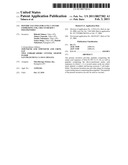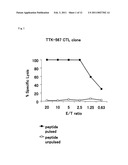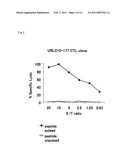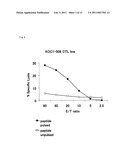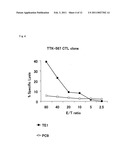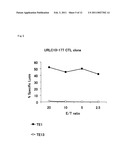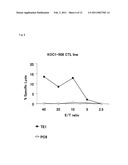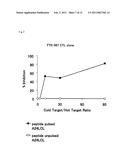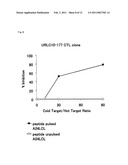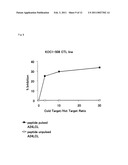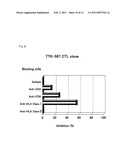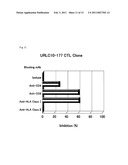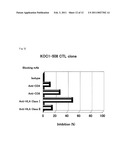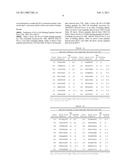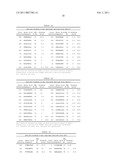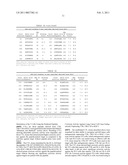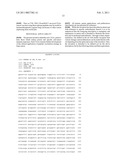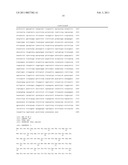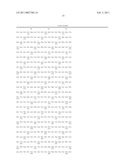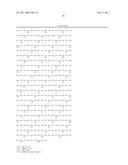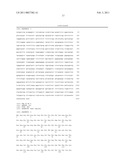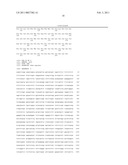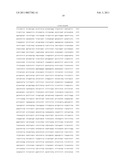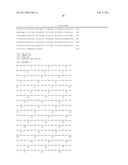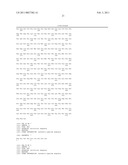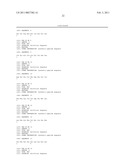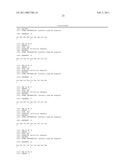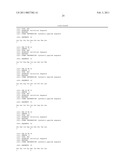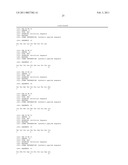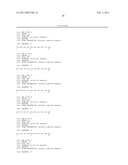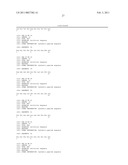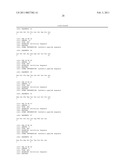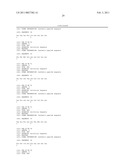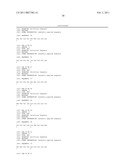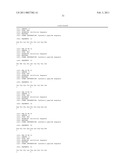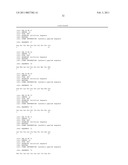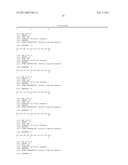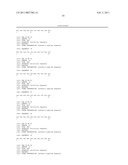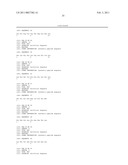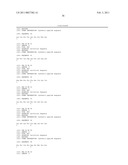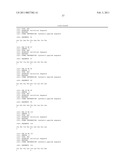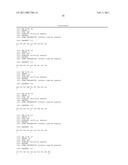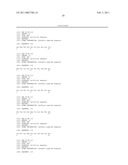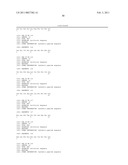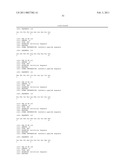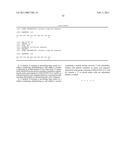Patent application title: PEPTIDE VACCINES FOR LUNG CANCERS EXPRESSING TTK, URLC10 OR KOC1 POLYPEPTIDES
Inventors:
Hideaki Tahara (Tokyo, JP)
Hideaki Tahara (Tokyo, JP)
Takuya Tsunoda (Tokyo, JP)
Takuya Tsunoda (Tokyo, JP)
Yusuke Nakamura (Tokyo, JP)
Yataro Daigo (Tokyo, JP)
Shuichi Nakatsuru (Kanagawa, JP)
Assignees:
Oncotherapy Science, Inc.
IPC8 Class: AA61K3900FI
USPC Class:
4241851
Class name: Drug, bio-affecting and body treating compositions antigen, epitope, or other immunospecific immunoeffector (e.g., immunospecific vaccine, immunospecific stimulator of cell-mediated immunity, immunospecific tolerogen, immunospecific immunosuppressor, etc.) amino acid sequence disclosed in whole or in part; or conjugate, complex, or fusion protein or fusion polypeptide including the same
Publication date: 2011-02-03
Patent application number: 20110027302
Claims:
1. A method of treating or preventing lung cancer in a subject comprising
administering to said subject a vaccine comprising an isolated peptide of
less than about 15 amino acids selected from the group consisting of
peptides comprising the amino acid sequences of SEQ ID NO: 8, 67, and 89,
an immunologically active fragment thereof, or a polynucleotide encoding
said peptide or immunologically active fragment.
2. A method of treating or preventing lung cancer in a subject comprising administering to said subject a vaccine comprising a peptide having cytotoxic T cell inducibility, wherein said peptide comprises an amino acid sequence selected from the group consisting of SEQ ID NO: 8, 67, and 89, wherein 1, 2, or several amino acids are substituted, deleted, or added.
Description:
[0001]This application is a divisional of U.S. patent application Ser. No.
11/816,616, filed Apr. 23, 2009, which is the U.S. National Stage entry
of International Application No. PCT/JP2006/303354, filed Feb. 17, 2006,
which claims the benefit of U.S. Provisional Application Ser. No.
60/656,857 filed Feb. 25, 2005, the contents of each are hereby
incorporated by reference in their entirety.
DESCRIPTION
[0002]1. Technical Field
[0003]The present invention relates to the field of biological science, more specifically to the field of cancer therapy. In particular, the present invention relates to novel peptides that are extremely effective as cancer vaccines, and drugs for treating and preventing tumors that contain these peptides.
[0004]2. Background Art
[0005]Lung cancer is one of the most commonly fatal human tumors. Many genetic alterations associated with the development and progression of lung cancer have been reported. Genetic changes can aid prognostic efforts and predictions of metastatic risk or response to certain treatments. (Mitsudomi T et al., (2000) Clin Cancer Res 6: 4055-63.; Niklinski et al., (2001) Lung Cancer. 34 Suppl 2: S53-8.; Watine J. (2000) Bmj 320: 379-80.). Non-small cell lung cancer (NSCLC) is by far the most common form of lung cancer, accounting for nearly 80% of lung tumors (Society, A. C. Cancer Facts and Figures 2001, 2001.). The overall 10-year survival rate remains as low as 10%, despite recent advances in multi-modality therapy, because the majority of NSCLCs are not diagnosed until advanced stages (Fry, W. A. et al., (1999) Cancer. 86: 1867-76.). Although chemotherapy regimens based on platinum are considered the reference standards for treatment of NSCLC, those drugs are able to extend survival of patients with advanced NSCLC only about six weeks (Non-small Cell Lung Cancer Collaborative Group, (1995) BMJ. 311: 899-909.). Numerous targeted therapies are being investigated for this disease, including tyrosine kinase inhibitors; however, to date promising results have been achieved in only a limited number of patients and some recipients suffer severe adverse reactions (Kris M G, et al., (2002) Proc Am Soc Clin Oncol. 21: 292a(A1166).).
[0006]It has been demonstrated that CD8' cytotoxic T lymphocytes (CTLs) recognize epitope peptides derived from tumor-associated antigens (TAAs) presented on MHC class I molecules, and lyse the tumor cells. Since the discovery of the MAGE family as the first example of TAAs, many other TAAs have been discovered using immunological approaches (Boon T. (1993) Int J Cancer 54: 177-80.; Boon T. et al., (1996) J Exp Med 183: 725-9.; van der Bruggen P et al., (1991) Science 254: 1643-47.; Brichard V et al., (1993) J Exp Med 178: 489-95.; Kawakami Y et al., (1994) J Exp Med 180: 347-52.). Some of them are now in clinical development as targets of immunotherapy. TAAs discovered so far include MAGE (van der Bruggen P et al., (1991) Science 254: 1643-7.), gp100 (Kawakami Y et al., (1994) J Exp Med 180: 347-52.), SART (Shichijo S et al., (1998) J Exp Med 187:277-88.), and NY-ESO-1 (Chen Y. T. et al., (1997) Proc. Natl. Acd. Sci. USA, 94: 1914-8.). On the other hand, certain gene products demonstrated to be somewhat specifically over-expressed in tumor cells have been shown to be recognized as targets inducing cellular immune responses. Such gene products include p53 (Umano Y et al., (2001) Br J Cancer, 84:1052-7.), HER2/neu (Tanaka H et al., (2001) Br Cancer, 84: 94-9.), CEA (Nukaya I et al., (1999) Int. J. Cancer 80, 92-7.) and the like.
[0007]Despite significant progress in basic and clinical research concerning TAAs (Rosenberg S A et al., (1998) Nature Med, 4: 321-7.; Mukherji B. et al., (1995) Proc Natl Acad Sci USA, 92: 8078-82.: Hu X et al., (1996) Cancer Res, 56: 2479-83.), only a very limited number of candidate TAAs suitable for treatment of adenocarcinomas, such as lung cancer, are available. TAAs that are abundantly expressed in cancer cells, and whose expression is restricted to cancer cells, would be promising candidates as immunotherapeutic targets.
[0008]It has been repeatedly shown in 51Cr-release assays that peptide-stimulated peripheral blood mononuclear cells (PBMCs) from certain healthy donors produce significant levels of IFN-γ in response to the peptide, but rarely exert cytotoxicity against tumor cells in an HLA-A24 or A0201 restricted manner (Kawano K et al., (2000) Cancer Res 60: 3550-8.; Nishizaka et al., (2000) Cancer Res 60: 4830-7.; Tamura et al., (2001) Jpn J Cancer Res 92: 762-7.). However, both HLA-A24 and HLA-A0201 are common HLA alleles in Japanese and Caucasian populations (Date Y et al., (1996) Tissue Antigens 47: 93-101.; Kondo A et al., (1995) J Immunol 155: 4307-12.; Kubo R T et al., (1994) J Immunol 152: 3913-24.; Imanishi et al., Proceeding of the eleventh International Histocompatibility Workshop and Conference Oxford University Press, Oxford, 1065 (1992); Williams F et al., (1997) Tissue Antigen 49: 129.). Thus, antigenic peptides of cancers presented by these HLA alleles may be especially useful for the treatment of cancers among Japanese and Caucasian patients. Further, it is known that the induction of low-affinity CTL in vitro usually results from the use of peptide at a high concentration, generating a high level of specific peptide/MHC complexes on antigen-presenting cells (APCs), which will effectively activate these CTL (Alexander-Miller et al., (1996) Proc Natl Acad Sci USA 93: 4102-7.).
[0009]Recent developments in cDNA microarray technologies have enabled the constructions of comprehensive profiles of gene expression of malignant cells as compared to normal cells (Okabe, H. et al., (2001) Cancer Res., 61, 2129-37.; Lin Y M. et al., (2002) Oncogene, 21; 4120-8.; Hasegawa S. et al., (2002) Cancer Res 62:7012-7.). This approach enables an understanding of the complex nature of cancer cells and the mechanisms of carcinogenesis and facilitates the identification of genes whose expression is deregulated in tumors (Bienz M. et al., (2000) Cell 103, 311-320.). Among the transcripts identified as commonly up-regulated in lung cancers, TTK (TTK Protein kinase; GenBank Accession No. NM--003318; SEQ ID Nos.1, 2), URLC10 (cDNA for differentially expressed CO16 gene; GenBank Accession No. AB105187; SEQ ID Nos.3, 4) and KOC1 (IGF II mRNA Binding Protein 3; GenBank Accession No. NM--006547; SEQ ID Nos.5, 6) are of particular interest to the present inventors, being specifically up-regulated in tumor cells of the lung cancer tissues in more than 80% of the cases analyzed. In contrast, Northern blot analysis demonstrated that these gene products are not found in normal vital organs (See WO2004/031413, the entire contents of which are incorporated by reference herein). Thus, immunogenic peptides derived from TTK, URLC10 and KOC1 may find utility in killing tumor cells expressing those antigens. The present invention addresses these and other needs.
SUMMARY OF THE INVENTION
[0010]Three genes, TTK (TTK Protein kinase), URLC10 (cDNA for differentially expressed CO16 gene) and KOC1 (IGF II mRNA Binding Protein 3) have been identified as up-regulated in lung cancer. The genes were identified using gene expression profiling with a genome-wide cDNA microarray containing 23,040 genes. As discussed above, expression of TTK, URLC10 and KOC1 is specifically up-regulated in tumor cells in more than 80% of the patients with lung cancer yet absent in other normal vital organs.
[0011]The present invention is based, at least in part, on the identification of epitope peptides of the gene products of these genes (TTK, URLC10, and KOC1) which elicit cytotoxic T lymphocytes (CTLs) specific to the corresponding molecules. As discussed in detail below, Peripheral Blood Mononuclear Cells (PBMC) of healthy donor were stimulated using HLA-A*2402 binding candidate peptides derived from TTK, URLC10 or KOC1. CTL clones were then established with specific cytotoxicity against the HLA-A24 positive target cells pulsed with each of the candidate peptides. Further analysis of the CTL clones showed the potent cytotoxic activity against, not only the peptide-pulsed target cells, but also tumor cells that endogenously express TTK, URLC10 or KOC1. Furthermore, both a cold target inhibition assay and an antibody blocking assay revealed that CTL cell clones specifically recognized the MHC class I-peptide complex. These results demonstrate that these peptides are HLA-A24 restricted epitope peptides that can induce potent and specific immune responses against lung cancer cells expressing TTK, URLC10 or KOC1.
[0012]Accordingly, the present invention provides methods for treating or preventing lung cancer in a subject comprising the step of administering to the subject the TTK, URLC10 and KOC1 polypeptides of the invention. Anti-tumor immunity is induced by the administration of these polypeptides. Thus, the present invention provides methods for inducing anti-tumor immunity in a subject comprising the step of administering to the subject the TTK, URLC10 and KOC1 polypeptides, as well as pharmaceutical compositions for treating or preventing lung cancer comprising the TTK, URLC10 and KOC1 polypeptides.
[0013]These and other objects and features of the invention will become more fully apparent when the following detailed description is read in conjunction with the accompanying figures and examples. However, it is to be understood that both the foregoing summary of the invention and the following detailed description are of preferred embodiments, and not restrictive of the invention or other alternate embodiments of the invention.
BRIEF DESCRIPTION OF THE DRAWINGS
[0014]FIG. 1 is a graph showing that the CTL clone raised by TTK-567 has peptide-specific cytotoxicity. Specifically, the CTL clone showed high cytotoxic activity against target cells (A24LCL) pulsed with TTK-567, whereas it did not show significant cytotoxic activity against the same target cells (A24LCL) pulsed with no peptides.
[0015]FIG. 2 is a graph showing that the CTL clone raised by URLC10-177 has peptide-specific cytotoxicity. Specifically, the CTL clone showed high cytotoxic activity against target cells (A24LCL) pulsed with URLC10-177, whereas it did not show significant cytotoxic activity against the same target cells (A24LCL) pulsed with no peptides.
[0016]FIG. 3 is a graph showing that the CTL clone raised by KOC1-508 has peptide-specific cytotoxicity. Specifically, the CTL clone showed high cytotoxic activity against target cells (A24LCL) pulsed with KOC1-508, whereas it did not show significant cytotoxic activity against the same target cells (A24LCL) pulsed with no peptides.
[0017]FIG. 4 is a graph showing that the CTL clone raised by TTK-567 recognizes and lyses tumor cells endogenously expressing TTK in an HLA restricted fashion. Cytotoxic activity against TE1 cells, which endogenously express TTK and HLA-A24, was tested using as effector cells the CTL clones raised by TTK-567. PC9 cells were used as the target cells that endogenously express TTK but do not express HLA-A24. The CTL clone showed high cytotoxic activity against TE1 cells that express both TTK and HLA-A24. On the other hand, it did not show significant cytotoxic activity against PC9 cells that express TTK but not HLA-A24.
[0018]FIG. 5 is a graph showing that the CTL clone raised by URLC10-177 recognizes and lyses tumor cells endogenously expressing URLC10 in an HLA restricted fashion. Cytotoxic activity against TE1 cells, which endogenously express URLC10 and HLA-A24, was tested using as effector cells the CTL clone raised by URLC10-177. TE13 cells were used as the target cells that endogenously express URLC10 but do not express HLA-A24. The CTL clone showed high cytotoxic activity against TE1 cells that express both URLC10 and HLA-A24. On the other hand, it did not show significant cytotoxic activity against TE13 cells that express URLC10, but not HLA-A24.
[0019]FIG. 6 is a graph showing that the CTL clone raised by KOC1-508 recognizes and lyses the tumor cells endogenously expressing KOC1 in an HLA restricted fashion. Cytotoxic activity against TE1 cells, which endogenously express KOC1 and HLA-A24, was tested using as effector cells the CTL clone raised by KOC1-508. PC9 cells were used as the target cells that endogenously express KOC1 but do not express HLA-A24. The CTL clone showed high cytotoxic activity against TE1 cells that express both KOC1 and HLA-A24. On the other hand, it did not show significant cytotoxic activity against PC9 cells that express KOC1, but not HLA-A24.
[0020]FIG. 7 is a graph showing that the CTL clone raised by TTK-567 specifically recognizes TTK-567 in an HLA-A24 restricted manner. TE1 cells labeled by Na251Cr O4 were prepared as hot target, while TTK-567 peptide-pulsed A24LCL cells were used as cold target (Inhibitor). The E/T ratio was fixed at 20. The cytotoxic activity of TTK-567 CTL clone against TE1 cells was inhibited by the addition of A24LCL cells pulsed with the identical peptide.
[0021]FIG. 8 is a graph showing that the CTL clone raised by URLC10-177 specifically recognizes URLC10 in an HLA-A24 restricted manner. TE1 cells labeled by Na251Cr O4 were prepared as hot target, while URLC10-177 peptide-pulsed A24LCL cells were used as cold target (Inhibitor). The E/T ratio was fixed at 20. The cytotoxic activity of URLC10-177 CTL clone against TE1 was inhibited by the addition of A24LCL cells pulsed with the identical peptide.
[0022]FIG. 9 is a graph showing that the CTL clone raised by KOC1-508 specifically recognizes KOC1 in an HLA-A24 restricted manner. TE1 cells labeled by Na251Cr O4 were prepared as hot target, while KOC1-508 peptide-pulsed A24LCL cells were used as cold target (Inhibitor). The E/T ratio was fixed at 20. The cytotoxic activity of KOC1-508 CTL clone against TE1 cells was inhibited by the addition of A24LCL cells pulsed with the identical peptide.
[0023]FIG. 10 is a graph showing that the cytotoxic activity of the CTL clone raised by TTK-567 is specifically blocked by antibodies recognizing the T-cell surface antigens of HLA class I or CD8. The specificity of cytotoxicity of the CTL clone was confirmed by an antibody blocking assay. TE1 cells were co-cultured with monoclonal antibodies respectively, and used as a target. The CTL activity was clearly blocked the addition of antibodies that recognize HLA Class I or CD8 and was marginally affected the addition of antibodies to HLA Class II or CD4; however, it was not inhibited at all by the addition of an isotype-matched control antibody.
[0024]FIG. 11 is a graph showing that the cytotoxic activity of the CTL clone raised by URLC10-177 is specifically blocked by antibodies recognizing the T-cell surface antigens of HLA class I or CD8. The specificity of cytotoxicity of the CTL clone was confirmed by an antibody blocking assay. TE1 cells were co-cultured with monoclonal antibodies respectively, and used as a target. The CTL activity was clearly blocked by the addition of antibodies that recognize HLA Class I or CD8 and was marginally affected by the addition of antibodies to HLA Class II or CD4; however, it was not inhibited at all by the addition of an isotype-matched control antibody.
[0025]FIG. 12 is a graph showing that the cytotoxic activity of the CTL clone raised by KOC1-508 is specifically blocked by antibodies recognizing the T-cell surface antigens of HLA class I or CD8. The specificity of cytotoxicity of the CTL clone was confirmed by an antibody blocking assay. TE1 cells were co-cultured with monoclonal antibodies respectively, and used as a target. The CTL activity was clearly blocked by the addition of antibodies that recognize HLA Class I or CD8 and was marginally affected by the addition of antibodies to HLA Class II or CD4; however, it was not inhibited at all by the addition of an isotype-matched control antibody.
DETAILED DESCRIPTION OF THE INVENTION
[0026]The words "a", "an", and "the" as used herein mean "at least one" unless otherwise specifically indicated.
[0027]Unless otherwise defined, all technical and scientific terms used herein have the same meaning as commonly understood by one of ordinary skill in the art to which this invention belongs.
Identification of new TAAs, particularly those that induce potent and specific anti-tumor immune responses, warrants further development of the clinical application of the peptide vaccination strategy in various types of cancer (Boon T et al., (1996) J Exp Med 183: 725-9.; van der Bruggen P et al., (1991) Science 254: 1643-7.; Brichard V et al., (1993) J Exp Med 178: 489-95.; Kawakami Y et al., (1994) J Exp Med 180: 347-52.; Shichijo S et al., (1998) J Exp Med 187:277-88.; Chen Y T et al., (1997) Proc. Natl. Acd. Sci. USA, 94: 1914-8.; Harris CC, (1996) J Natl Cancer Inst 88:1442-5.; Butterfield L H et al., (1999) Cancer Res 59:3134-42.; Vissers J L et al., (1999) Cancer Res 59: 5554-9.; van der Burg S H et al., (1996) J. Immunol. 156:3308-14.; Tanaka F et al., (1997) Cancer Res 57:4465-8.; Fujie T et al., (1999) Int J Cancer 80:169-72.; Kikuchi M et al., (1999) Int J Cancer 81: 459-66.; Oiso M et al., (1999) Int J Cancer 81:387-94.). As noted above, TTK, URLC10 and KOC1 were previously identified as over-expressed in lung cancer using cDNA microarray technologies. As discussed in WO2004/031413, TTK encodes an S_TKc domain. The protein encoded by the TTK gene phosphorylates proteins on serine, threonine and tyrosine, such phosphorylation likely associated with cell proliferation (Mills G B et al., (1992) J Biol Chem 267: 16000-6.; Schmandt R et al., (1994) J. Immunol.; 152(1):96-105.; Stucke V M et al., (2002) EMBO J.; 21(7):1723-32.). KOC1 encodes insulin-like growth factor 2 (IGF2) mRNA-binding protein 3 (IMP-3). IMP-3 protein contains 2 functional RNA recognition motifs (RRM) in addition to the 4 KH domains. The protein associates specifically with the 5-prime UTR of the human 6.0-kb insulin-like growth factor II (IGF2) leader-3 mRNA, suggesting a role for IMP-3 in the physiologic regulation of IGF2 production. (Nielsen, J. et al., (1999) Molec. Cell. Biol. 19: 1262-1270) IMP-3 was also over-expressed in pancreatic cancers (Mueller-Pillasch, F. et al., (1997) Oncogene 14: 2729-2733).
[0028]Previous experiments demonstrated that TTK, URLC10 and KOC1 were over-expressed in lung cancer and show minimal expression in normal tissues. In addition, these genes were shown to have a significant function related to cell proliferation (See WO2004/031413).
[0029]In the present invention, peptides derived from TTK, URLC10 or KOC1 are shown to be TAA epitopes restricted by HLA-A24, an HLA allele commonly found in the Japanese and Caucasian populations. Specifically, using their binding affinities to HLA-A24, candidates of HLA-A24 binding peptides derived from TTK, URLC10 or KOC1 were identified. After the in vitro stimulation of T-cells by dendritic cells (DCs) loaded with these peptides, CTLs were successfully established using TTK-567 (SYRNEIAYL (SEQ ID No.8)), URLC10-177 (RYCNLEGPPI (SEQ ID No.67)) and KOC1-508 (KTVNELQNL (SEQ ID No.89)). These CTLs showed potent cytotoxic activity against the peptide-pulsed A24LCL cells. Furthermore, CTL clones derived from these cells also showed specific cytotoxicity against HLA-A24 positive lung carcinoma cell lines that endogenously over-express TTK, URLC10 or KOC1. However, these CTL clones did not show cytotoxic activity against cell lines lacking expression of either HLA-A24 or target TAA. The specific cytotoxic activities of these CTL clones were significantly inhibited by the cold target. These results demonstrate that TTK, URLC10 and KOC1 are useful as TAAs of lung cancer cells and that TTK-567, KOC1-508 and URLC10-177 are epitope peptides of each TAA restricted by HLA-A24. Since these antigens are over-expressed in most lung cancers and are associated with tumor cell proliferation, they find utility as immunotherapeutic targets against lung cancers.
[0030]Accordingly, the present invention further provides methods of treating or preventing lung cancer in a subject, said methods comprising the steps of administering an immunogenic peptide of less than about 40 amino acids, often less than about 20 amino acids, usually less than about 15 amino acids and comprising the amino acid sequence of SEQ ID NOs: 8, 67, or 89 to the subject in need thereof. Alternatively, the immunogenic peptide may comprise a sequence of SEQ ID NOs: 8, 67, or 89 in which 1, 2, or several amino acids are substituted, deleted or added, provided the resulting variant peptide retains the immunogenic activity (i.e., the ability to induce CTLs specific to lung cancer cells). The number of residues to be substituted, deleted, or added is generally 5 amino acids or less, preferably 4 amino acids or less, more preferably 3 amino acids or less, even more preferably one or two amino acids.
[0031]Variant peptides (i.e., peptides comprising an amino acid sequence modified by substituting, deleting, or adding one, two or several amino acid residues to an original amino acid sequence) have been known to retain the original biological activity (Mark D F et al., (1984) Proc Natl Acad Sci USA 81: 5662-6.; Zoller M J and Smith M, (1982) Nucleic Acids Res 10:6487-500.; Dalbadie-McFarland G et al., (1982) Proc Natl Acad Sci USA 79: 6409-13.). In the context of the present invention, the amino acid modification results in conservation of the properties of the original amino acid side-chain (a process known as conservative amino acid substitution). Examples of properties of amino acid side chains are hydrophobic amino acids (A, I, L, M, F, P, W, Y, V), hydrophilic amino acids (R, D, N, C, E, Q, G, H, K, S, T), and side chains having the following functional groups or characteristics in common: an aliphatic side-chain (G, A, V, L, I, P); a hydroxyl group containing side-chain (S, T, Y); a sulfur atom containing side-chain (C, M); a carboxylic acid and amide containing side-chain (D, N, E, Q); a base containing side-chain (R, K, H); and an aromatic containing side-chain (H, F, Y, W). Note, the parenthetic letters indicate the one-letter codes of amino acids.
[0032]In preferred embodiments, the immunogenic peptide is a nonapeptide (9-mer) or a decapeptide (10-mer).
[0033]The present invention further provides a method of inducing anti-tumor immunity for lung cancer in a subject, said method comprising the steps of administering to the subject an immunogenic peptide of the invention, namely one comprising the amino acid sequence of SEQ ID NOs: 8, 67, or 89 or a variant thereof (i.e., including 1, 2, or several amino acid substitutions, deletions, or additions) to the subject in need thereof.
[0034]In the context of the present invention, the subject is preferably a mammal. Exemplary mammals include, but are not limited to, e.g., a human, non-human primate, mouse, rat, dog, cat, horse, or cow.
[0035]In the present invention, the peptide can be administered to a subject via in vivo or ex vivo. Furthermore, the present invention also provides use of nonapeptide or decapeptide selected from peptides comprising the amino acid sequence of SEQ ID NOs: 8, 67, and 89 (and variants thereof) for manufacturing an immunogenic composition for treating or preventing lung cancer.
[0036]Homology analyses of TTK-567, KOC1-508 and URLC10-177 demonstrate that they do not have significant homology with the peptides derived from any known human gene products. Accordingly, the possibility of unknown or undesirable immune responses with immunotherapy against these molecules is significantly reduced.
[0037]Regarding HLA antigens, the use of an A-24 type that is highly expressed among the Japanese population is favorable for obtaining effective results, and the use of subtypes, such as A-2402, is even more preferable. Typically, in the clinic, the type of HLA antigen of the patient requiring treatment is investigated in advance, which enables the appropriate selection of peptides having high levels of binding affinity to this antigen, or having cytotoxic T cell (CTL) inducibility by antigen presentation. Furthermore, in order to obtain peptides showing high binding affinity and CTL inducibility, substitution, deletion, or addition of 1, 2, or several amino acids may be performed based on the amino acid sequence of the naturally occurring TTK, URLC10 and KOC1 partial peptide. Herein, the term "several" means refers to 5 or less, more preferably 3 or less. Furthermore, in addition to peptides that are naturally displayed, since the regularity of the sequences of peptides displayed by binding to HLA antigens is already known (Kubo R T, et al., (1994) J. Immunol., 152, 3913-24.; Rammensee H G, et al., (1995) Immunogenetics. 41:178-228.; Kondo A, et al., (1995) J. Immunol. 155:4307-12.), modifications based on such regularity can be performed on the immunogenic peptides of the invention. For example, peptides showing high HLA-24 binding affinity in which the second amino acid from the N terminus substituted with phenylalanine, tyrosine, methionine, or tryptophan may be favorably used. Likewise, peptides whose C-terminal amino acid is substituted with phenylalanine, leucine, isoleucine, tryptophan, or methionine may also be used favorably.
[0038]However, when the peptide sequence is identical to a portion of the amino acid sequence of an endogenous or exogenous protein having a different function, side effects such as autoimmune disorders or allergic symptoms against specific substances may be induced. Therefore, it is preferable to avoid the situation wherein the immunogenic sequence matches the amino acid sequence of a known protein. This situation may be avoided by performing a homology search using available databases. If homology searches confirm that peptides in which 1, 2 or several different amino acids do not exist, then the danger that modifications of the above-mentioned amino acid sequence that, for example, increase the binding affinity with HLA antigens, and/or increase the CTL inducibility can be avoided.
[0039]Although peptides having high binding affinity to the HLA antigens as described above are expected to be highly effective as cancer vaccines, the candidate peptides, which are selected according to the presence of high binding affinity as an indicator, must be examined for the actual presence of CTL inducibility. CTL inducibility may be confirmed by inducing antigen-presenting cells carrying human MHC antigens (for example, B-lymphocytes, macrophages, and dendritic cells), or more specifically dendritic cells derived from human peripheral blood mononuclear leukocytes, and, after stimulation with the peptide of interest, mixing with CD8-positive cells and measuring the cytotoxic activity against the target cells. As the reaction system, transgenic animals produced to express a human HLA antigen (for example, those described in BenMohamed L, et al., (2000) Hum. Immunol.; 61(8):764-79 Related Articles, Books, Linkout.) may be used. For example, the target cells can be radio-labeled with 51Cr and such, and cytotoxic activity can be calculated from radioactivity released from the target cells. Alternatively, it can be examined by measuring IFN-γ produced and released by CTL in the presence of antigen-presenting cells that carry immobilized peptides, and visualizing the inhibition zone on the media using anti-IFN-γ monoclonal antibodies.
[0040]As a result of examining the CTL inducibility of peptides as described above, it was discovered that peptides having high binding affinity to an HLA antigen did not necessarily have high inducibility. However, nonapeptides or decapeptides selected from peptides comprising the amino acid sequences indicated by SYRNEIAYL (SEQ ID NO: 8), RYCNLEGPPI (SEQ ID NO: 67), KTVNELQNL (SEQ ID NO: 89) showed particularly high CTL inducibility.
[0041]As noted above, the present invention provides peptides having cytotoxic T cell inducibility, namely those comprising the amino acid sequence of SEQ ID NOS: 8, 67, or 89 or a variant thereof (i.e., those in which 1, 2, or several amino acids are substituted, deleted, or added). It is preferably that the amino acid sequence comprise 9 or 10 amino acids indicated in SEQ ID NOS: 8, 67, 89 or a variant thereof do not match an amino acid sequence associated with another endogenous protein. In particular, amino acid substitution to phenylalanine, tyrosine, methionine, or tryptophan at the second amino acid from the N terminus, and to phenylalanine, leucine, isoleucine, tryptophan, or methionine at the C-terminal amino acid, and amino acid addition of 1 to 2 amino acids at the N terminus and/or C terminus are favorable examples.
[0042]Peptides of the present invention can be prepared using well known techniques. For example, the peptides can be prepared synthetically, using either recombinant DNA technology or chemical synthesis. Peptides of the present invention may be synthesized individually or as longer polypeptides comprising two or more peptides. The peptides of the present invention are preferably isolated, i.e., substantially free of other naturally occurring host cell proteins and fragments thereof.
[0043]The peptides of the present invention may contain modifications, such as glycosylation, side chain oxidation, or phosphorylation; so long as the modifications do not destroy the biological activity of the peptides as described herein. Other modifications include incorporation of D-amino acids or other amino acid mimetics that can be used, for example, to increase the serum half life of the peptides.
[0044]The peptides of this invention can be prepared as a combination, which comprises two or more of peptides of the invention, for use as a cancer vaccine that may induce CTL in vivo. The peptides may be in a cocktail or may be conjugated to each other using standard techniques. For example, the peptides can be expressed as a single polypeptide sequence. The peptides in the combination may be the same or different. By administering the peptides of this invention, the peptides are presented at a high density on the HLA antigens of antigen-presenting cells, which, in turn, induces CTLs that specifically react toward the complex formed between the displayed peptide and the HLA antigen. Alternatively, antigen-presenting cells having immobilized the peptides of this invention on their cell surface, obtained by removing dendritic cells from the subjects, may be stimulated by the peptides of this invention. Re-administration of these cells to the respective subjects induces CTL, and, as a result, aggressiveness towards the target cells can be increased.
[0045]More specifically, the present invention provides drugs for treating tumors or preventing proliferation, metastasis, and such of tumors, which comprise one or more of peptides of this invention. The peptides of this invention find particular utility in the treatment of tumors, such as lung cancer.
[0046]The peptides of this invention can be administered to a subject directly, as a pharmaceutical composition that has been formulated by conventional formulation methods. In such cases, in addition to the peptides of this invention, carriers, excipients, and such that are ordinarily used for drugs can be included as appropriate, without particular limitations. The immunogenic compositions of this invention may be used for treatment and prevention of various tumors, including lung cancers.
[0047]The immunogenic compositions for treatment and/or prevention of tumors, which comprise as the active ingredient one or more peptides of the present invention, can further include an adjuvant so that cellular immunity will be established effectively. Alternatively, they may be administered with other active ingredients, such as anti-tumor agents. Suitable formulations include granules. Suitable adjuvants are described in the literature (Johnson A G. (1994) Clin. Microbiol. Rev., 7:277-89.). Exemplary adjuvants include, but are not limited to, aluminum phosphate, aluminum hydroxide, and alum. Furthermore, liposome formulations, granular formulations in which the drug is bound to few-μm diameter beads, and formulations in which a lipid is bound to the peptide may be conveniently used. The method of administration may be oral, intradermal, subcutaneous, intravenous injection, or such, and may include systemic administration or local administration to the vicinity of the targeted tumor. The dose of the peptide(s) of this invention can be adjusted appropriately according to the disease to be treated, age of the patient, weight, method of administration, and such. Though the dosage is ordinarily 0.001 mg to 1000 mg, preferably 0.01 mg to 100 mg, more preferably 0.1 mg to 10 mg, preferably administered once in a few days to few months, one skilled in the art can readily select the appropriate dose and method of administration, as, the selection and optimization of these parameters is well within routine skill.
[0048]The present invention further provides intracellular vesicles called exosomes, which present complexes formed between the peptides of this invention and HLA antigens on their surface. Exosomes can be prepared, for example, by using the methods described in detail in Published Japanese Translation of International Publication Nos. Hei 11-510507 and 2000-512161, and are preferably prepared using antigen-presenting cells obtained from subjects who are targets of treatment and/or prevention. The exosomes of this invention can be inoculated as cancer vaccines, similarly to the peptides of this invention.
[0049]The type of HLA antigens used must match that of the subject requiring treatment and/or prevention. For example, in the Japanese population, HLA-A24, particularly HLA-A2402, is often appropriate.
[0050]In some embodiments, the vaccine compositions of the present invention include a component which primes cytotoxic T lymphocytes. Lipids have been identified as agents capable of priming CTL in vivo against viral antigens. For example, palmitic acid residues can be attached to the ε- and α-amino groups of a lysine residue and then linked to an immunogenic peptide of the invention. The lipidated peptide can then be administered either directly, in a micelle or particle, incorporated into a liposome, or emulsified in an adjuvant. As another example of a lipid priming of CTL responses, E. coli lipoproteins, such as tripalmitoyl-S-glycerylcysteinlyseryl-serine (P3CSS), can be used to prime CTL when covalently attached to an appropriate peptide (see, e.g., Deres K, et al., (1989) Nature 342:561-4.).
[0051]The immunogenic compositions of the present invention may also comprise nucleic acids encoding one or more of the immunogenic peptides disclosed here. See, e.g., Wolff J A et al., (1990) Science 247:1465-8; U.S. Pat. Nos. 5,580,859; 5,589,466; 5,804,566; 5,739,118; 5,736,524; 5,679,647; and WO 98/04720. Examples of DNA-based delivery technologies include "naked DNA", facilitated (bupivicaine, polymers, peptide-mediated) delivery, cationic lipid complexes, and particle-mediated ("gene gun") or pressure-mediated delivery (see, e.g., U.S. Pat. No. 5,922,687).
[0052]The immunogenic peptides of the invention can also be expressed by viral or bacterial vectors. Examples of suitable expression vectors include attenuated viral hosts, such as vaccinia or fowlpox. This approach involves the use of vaccinia virus, e.g., as a vector to express nucleotide sequences that encode the peptide. Upon introduction into a host, the recombinant vaccinia virus expresses the immunogenic peptide, and thereby elicits an immune response. Vaccinia vectors and methods useful in immunization protocols are described in, e.g., U.S. Pat. No. 4,722,848. Another suitable vector is BCG (Bacille Calmette Guerin). BCG vectors are described in Stover C K, et al., (1991) Nature 351:456-60. A wide variety of other vectors useful for therapeutic administration or immunization e.g., adeno and adeno-associated virus vectors, retroviral vectors, Salmonella typhi vectors, detoxified anthrax toxin vectors, and the like, are known in the art. See, e.g., Shata M T, et al., (2000) Mol. Med. Today 6:66-71; Shedlock D J and Weiner D B., et al., (2000) J. Leukoc. Biol. 68:793-806; and Hipp J D, et al., (2000) In Vivo 14:571-85.
[0053]The present invention also provides methods of inducing antigen-presenting cells using one or more peptides of this invention. The antigen-presenting cells can be induced by inducing dendritic cells from the peripheral blood monocytes and then contacting (stimulating) them with one or more peptides of this invention in vitro, ex vivo or in vivo. When peptides of the present invention are administered to the subjects, antigen-presenting cells that have the peptides of this invention immobilized to them are induced in the body of the subject. Alternatively, after immobilizing the peptides of this invention to the antigen-presenting cells, the cells can be administered to the subject as a vaccine. For example, the ex vivo administration may comprise steps of:
[0054]a: collecting antigen-presenting cells from a subject, and
[0055]b: contacting the antigen-presenting cells of step a with a peptide of the present invention.
[0056]The antigen-presenting cells obtained by step b can be administered to the subject as a vaccine.
[0057]This invention also provides a method for inducing antigen-presenting cells having a high level of cytotoxic T cell inducibility, in which the method comprises the step of transferring genes comprising polynucleotide(s) encoding one or more peptides of this invention to antigen-presenting cells in vitro. The introduced genes may be in the form of DNAs or RNAs. For the method of introduction, without particular limitations, various methods conventionally performed in this field, such as lipofection, electroporation, and calcium phosphate method may be suitably used. More specifically, transfection may be performed as described in Reeves M E, et al., (1996) Cancer Res., 56:5672-7.; Butterfield L H, et al., (1998) J. Immunol., 161:5607-13.; Boczkowski D, et al., (1996) J. Exp. Med., 184:465-72.; Published Japanese Translation of International Publication No. 2000-509281. By transferring the gene into antigen-presenting cells, the gene undergoes transcription, translation, and such in the cell, and then the obtained protein is processed by MHC Class I or Class II, and proceeds through a presentation pathway to present partial peptides.
[0058]The present invention further provides methods for inducing CTL using one or more peptides of this invention. When the peptides of this invention are administered to a subject, CTL are induced in the body of the subject, and the strength of the immune system targeting the lung cancer cells in the tumor tissues is thereby enhanced. Alternatively, the peptides of the present invention may be used in the context of an ex vivo therapeutic method, in which subject-derived antigen-presenting cells and CD8-positive cells or peripheral blood mononuclear leukocytes are contacted (stimulated) with one or more peptides of this invention in vitro, and, after inducing CTL, the cells are returned to the subject. For example, the method may comprise steps of:
[0059]a: collecting antigen-presenting cells from a subject,
[0060]b: contacting the antigen-presenting cells of step a with a peptide of the present invention,
[0061]c: mixing the antigen-presenting cells of step b with CD8+ T cells and co-culturing so as to induce cytotoxic T-cells, and
[0062]d: collecting CD8+ T cells from the co-culture of step c.
[0063]The CD8+ T cells having cytotoxic activity obtained by step d can be administered to the subject as a vaccine.
[0064]The present invention further provides isolated cytotoxic T cells induced using the peptides of this invention. The cytotoxic T cells, induced by stimulation with an antigen-presenting cell presenting one or more peptides of this invention, are preferably derived from subjects who are the target of treatment and/or prevention, and can be administered alone or in combination with other drugs, including one or more peptides of this invention or exosomes having anti-tumor activity. The obtained cytotoxic T cells act specifically against target cells presenting the peptides of this invention, or preferably the same peptide(s) used for induction. The target cells may be cells that express TTK, URLC10 and KOC1 endogenously, or cells that are transfected with TTK, URLC10 and KOC1 genes. Cells that present the peptides of this invention on the cell surface, due to stimulation with these peptides, can also become targets of attack.
[0065]The present invention also provides antigen-presenting cells presenting complexes formed between HLA antigens and one or more peptides of this invention. The antigen-presenting cells, obtained through contact with the peptides of this invention or the nucleotides encoding such peptides, are preferably derived from subjects who are the target of treatment and/or prevention, and can be administered as vaccines, alone or in combination with other drugs, including the peptides, exosomes, or cytotoxic T cells of the present invention.
[0066]In the context of the present invention, the term "vaccine" (also referred to as an immunogenic composition) refers to a substance that induces anti-tumor immunity or suppresses lung cancer upon inoculation into animals. According to the present invention, polypeptides comprising the amino acid sequence of SEQ ID NO: 8, 67, or 89 were suggested to be HLA-A24 restricted epitope peptides that may induce potent and specific immune response against lung cancer cells expressing TTK, URLC10 or KOC1. Thus, the present invention also encompasses a method of inducing anti-tumor immunity using polypeptides comprising the amino acid sequence of SEQ ID NO: 8, 67, or 89 or a variant thereof (i.e., including 1, 2, or several amino acid substitutions, deletions, or additions). In general, anti-tumor immunity includes immune responses such as follows: [0067]induction of cytotoxic lymphocytes against tumors comprising cells expressing TTK, URLC10, or KOC1, [0068]induction of antibodies that recognize tumors comprising cells expressing TTK, URLC10, or KOC1, and [0069]induction of anti-tumor cytokine production.
[0070]Therefore, when a certain peptide induces any one of these immune responses upon inoculation into an animal, the peptide is decided to have anti-tumor immunity inducing effect. The induction of the anti-tumor immunity by a peptide can be detected by observing in vivo or in vitro the response of the immune system in the host against the peptide.
[0071]For example, a method for detecting the induction of cytotoxic T lymphocytes is well known. A foreign substance that enters the living body is presented to T cells and B cells by the action of antigen-presenting cells (APCs). T cells that respond to the antigen presented by APC in antigen specific manner differentiate into cytotoxic T cells (also referred to as cytotoxic T lymphocytes or CTLs) due to stimulation by the antigen, and then proliferate; this process is referred to herein as "activation" of T cells. Therefore, CTL induction by a certain peptide can be evaluated by presenting the peptide to a T cell by APC, and detecting the induction of CTL. Furthermore, APCs have the effect of activating CD4+ T cells, CD8+ T cells, macrophages, eosinophils and NK cells. Since CD4+ T cells are also important in anti-tumor immunity, the anti-tumor immunity inducing action of the peptide can be evaluated using the activation effect of these cells as indicators.
[0072]A method for evaluating the inducing action of CTL using dendritic cells (DCs) as APC is well known in the art. DC is a representative APC having the strongest CTL inducing action among APCs. In this method, the test polypeptide is initially contacted with DC and then this DC is contacted with T cells. Detection of T cells having cytotoxic effects against the cells of interest after the contact with DC shows that the test polypeptide has an activity of inducing the cytotoxic T cells. Activity of CTL against tumors can be detected, for example, using the lysis of 51Cr-labeled tumor cells as the indicator. Alternatively, it is well known to evaluate the degree of tumor cell damage using 3H-thymidine uptake activity or LDH (lactose dehydrogenase)-release as the indicator.
[0073]Apart from DC, peripheral blood mononuclear cells (PBMCs) may also be used as the APC. The induction of CTL is reported to be enhanced by culturing PBMC in the presence of GM-CSF and IL-4. Similarly, CTL has been shown to be induced by culturing PBMC in the presence of keyhole limpet hemocyanin (KLH) and IL-7.
[0074]The test polypeptides confirmed to possess CTL inducing activity by these methods are polypeptides having DC activation effect and subsequent CTL inducing activity. Therefore, polypeptides that induce CTL against tumor cells are useful as vaccines against lung cancer. Furthermore, APC that have acquired the ability to induce CTL against lung cancer by contacting with the polypeptides are useful as vaccines against lung cancer. Furthermore, CTL that have acquired cytotoxicity due to presentation of the polypeptide antigens by APC can be also used as vaccines against lung cancer. Such therapeutic methods for lung cancer, using anti-tumor immunity due to APC and CTL, are referred to as cellular immunotherapy.
[0075]Generally, when using a polypeptide for cellular immunotherapy, efficiency of the CTL-induction can be increased by combining a plurality of polypeptides having different structures and contacting them with DC. Therefore, when stimulating DC with protein fragments, it is advantageous to use a mixture of multiple types of fragments.
[0076]The induction of anti-tumor immunity by a polypeptide can be further confirmed by observing the induction of antibody production against tumors. For example, when antibodies against a polypeptide are induced in a laboratory animal immunized with the polypeptide, and when growth, proliferation and/or metastasis of tumor cells is suppressed by those antibodies, the polypeptide is determined to induce anti-tumor immunity.
[0077]Anti-tumor immunity can be induced by administering a vaccine of this invention, and the induction of anti-tumor immunity enables treatment and prevention of lung cancer. Therapy against or prevention of the onset of lung cancer may include inhibition of the growth of lung cancer cells, involution of lung cancer cells and suppression of occurrence of lung cancer cells. Decrease in mortality of individuals having lung cancer, decrease of lung cancer markers in the blood, alleviation of detectable symptoms accompanying lung cancer and such are also included in the therapy or prevention of lung cancer. Such therapeutic and preventive effects are preferably statistically significant, for example, observed at a significance level of 5% or less, wherein the therapeutic or preventive effect of a vaccine against lung cancer is compared to a control without vaccine administration. For example, Student's t-test, the Mann-Whitney U-test or ANOVA may be used for determining statistical significance.
[0078]The above-mentioned peptide, having immunological activity, or a polynucleotide or vector encoding such a peptide, may be combined with an adjuvant. An adjuvant refers to a compound that enhances the immune response against the peptide when administered together (or successively) with the peptide having immunological activity. Examples of suitable adjuvants include cholera toxin, salmonella toxin, alum and such, but are not limited thereto. Furthermore, a vaccine of this invention may be combined appropriately with a pharmaceutically acceptable carrier. Examples of such carriers are sterilized water, physiological saline, phosphate buffer, culture fluid and such. Furthermore, the vaccine may contain as necessary, stabilizers, suspensions, preservatives, surfactants and such. The vaccine is administered systemically or locally. Vaccine administration may be performed by single administration or boosted by multiple administrations.
[0079]When using APC or CTL as the vaccine of this invention, lung cancer can be treated or prevented, for example, by the ex vivo method. More specifically, PBMCs of the subject receiving treatment or prevention are collected, contacted ex vivo with a peptide of the present invention. Following the induction of APC or CTL, the cells may be administered to the subject. APC can be also induced by introducing a vector encoding the peptide into PBMCs ex vivo. APC or CTL induced in vitro can be cloned prior to administration. By cloning and growing cells having high activity of damaging target cells, cellular immunotherapy can be performed more effectively. Furthermore, APC and CTL isolated in this manner may be used for cellular immunotherapy not only against individuals from whom the cells are derived, but also against similar types of diseases in other individuals.
[0080]Aspects of the present invention are described in the following examples, which are presented only to illustrate the present invention and to assist one of ordinary skill in making and using the same. The examples are not intended in any way to otherwise limit the scope of the invention.
[0081]Although methods and materials similar or equivalent to those described herein can be used in the practice or testing of the present invention, suitable methods and materials are described below.
Examples
[0082]The present invention is illustrated, but not restricted, by following Examples.
Materials and Methods
Cell Lines
[0083]A24LCL cells (HLA-A24/24) and EHM (HLA-A3/3), human B-lymphoblastoid cell lines, were generous gifts from Takara Shuzo Co, Ltd. (Otsu, Japan). The A24LCL cells were used for peptide-mediated cytotoxicity assays. Lung carcinoma cell lines TE1 (HLA-A2402+), TE13 (HLA-A2402-) and PC9 (HLA-A2402-) were purchased from ATCC. Expression levels of TTK, URLC10 and KOC1 in the lung carcinoma cell lines were determined by cDNA microarray and RT-PCR that revealed strong expression of all three genes in TE1, TTK and KOC1 expression in PC9, and URLC10 expression in TE13 (data not shown).
Candidate Selection of Peptide Derived from TTK, URLC10 and KOC1
[0084]9-mer and 10-mer peptides derived from TTK, URLC10 or KOC1 that bind to HLA-A24 molecule were predicted by binding prediction software "BIMAS" (http://bimas.dcrt.nih.gov/cgi-bin/molbio/ken_parker_comboform) (Parker K C, et al., (1994) J. Immunol.;152(1):163-75.; Kuzushima K, et al., (2001) Blood.; 98(6):1872-81.). These peptides were synthesized by Mimotopes (San Diego, LA) according to the standard solid phase synthesis method and purified by reversed phase HPLC. The purity (>90%) and the identity of the peptides were determined by analytical HPLC and mass spectrometry analysis, respectively. Peptides were dissolved in dimethylsulfoxide (DMSO) at 20 mg/ml and stored at -80° C.
In Vitro CTL Induction
[0085]Monocyte-derived dendritic cells (DCs) were used as antigen-presenting cells (APCs) to induce CTL responses against peptides presented on HLA. DCs were generated in vitro as described elsewhere (Nukaya I et al., (1999) Int. J. Cancer 80, 92-7., Tsai V et al., (1997) J. Immunol. 158:1796-802.). Briefly, peripheral blood mononuclear cells (PBMCs) isolated from a normal volunteer (HLA-A*2402) by Ficoll-Paque (Pharmacia) solution were separated by adherence to a plastic tissue culture flask (Becton Dickinson) so as to enrich them for the monocyte fraction. The monocyte-enriched population was cultured in the presence of 1000 U/ml of GM-CSF (provided by Kirin Brewery Company) and 1000 U/ml of IL-4 (Genzyme) in AIM-V (Invitrogen) containing 2% heat-inactivated autologous serum (AS). After 7 days in the culture, the cytokine-generated DCs were pulsed with 20 μg/ml of HLA-A24-binding peptides in the presence of 3 μg/ml of 132-microglobulin for 4 hrs at 20° C. in AIM-V. These peptide-pulsed DCs were then irradiated (5500 rad) and mixed at a 1:20 ratio with autologous CD8+ T cells, obtained by positive selection with Dynabeads M-450 CD8 (Dynal) and DETACHa BEAD® (Dynal). These cultures were set up in 48-well plates (Corning); each well contained 1.5×104 peptide-pulsed DCs, 3×105 CD8+ T cells and 10 ng/ml of IL-7 (Genzyme) in 0.5 ml of AIM-V/2% AS. Three days later, these cultures were supplemented with IL-2 (CHIRON) to a final concentration of 20 IU/ml. On day 7 and 14, the T cells were further restimulated with the autologous peptide-pulsed DCs. The DCs were prepared each time by the same way described above. Cytotoxicity was tested against peptide-pulsed A24LCL cells after the 3rd round of peptide stimulation on day 21.
CTL Expansion Procedure
[0086]CTLs were expanded in culture using the method similar to the one described by Riddell S R, et al., (Walter E A et al., (1995) N Engl J Med 333:1038-44., Riddel et al., (1996) Nature Med. 2:216-23.). A total 5×104 of CTLs were resuspended in 25 ml of AIM-V/5% AS with 25×106 irradiated (3300 rad) PBMC and 5×106 irradiated (8000 rad) EHM cells in the presence of 40 ng/ml of anti-CD3 monoclonal antibody (Pharmingen). One day after initiating the cultures, 120 IU/ml of IL-2 were added to the cultures. The cultures were fed with fresh AIM-V/5% AS containing 30 IU/ml of IL-2 on days 5, 8 and 11.
Establishment of CTL Clones
[0087]The dilutions were made to have 0.3, 1, and 3 CTLs/well in 96 round-bottomed micro titer plate (Nalge Nunc International). CTLs were cultured with 7×104 cells/well of allogenic PBMCs, 1×104 cells/well of EHM, 30 ng/ml of anti-CD3 antibody, and 125 U/ml of IL-2 in total of 150 μl/well of AIM-V containing 5% AS. 50 μl/well of IL-2 was added to the medium 10 days later so that IL-2 became 125 U/ml in the final concentration. Cytotoxic activity of CTLs was tested on the 14th day, and CTL clones were expanded using the same method above.
Cytotoxicity Assay
[0088]Target cells were labeled with 100 μCi of Na251CrO4 for 1 hr at 37° C. in a CO2 incubator (Perkin Elmer Life Sciences). Peptide-pulsed targets were prepared by incubating the cells with 20 μm/ml of the peptide for 16 hrs at 37° C. before labeling. Labeled target cells were rinsed and mixed with effector cells in a final volume of 0.2 ml in round-bottom microtiter plates. The plates were centrifuged (4 minutes at 800×g) to increase cell-to-cell contact and placed in a CO2 incubator at 37° C. After 4 hrs of incubation, 0.1 ml of the supernatant was collected from each well and the radioactivity was determined with a gamma counter.
[0089]The percentage of specific cytotoxicity was determined by calculating the percentage of specific 51Cr-release by the following formula:
{(cpm of the test sample release-cpm of the spontaneous release)/(cpm of the maximum release-cpm of the spontaneous release)}×100.
[0090]Spontaneous release was determined by incubating the target cells alone, in the absence of effector cells, and the maximum release was obtained by incubating the target cells with 1N HCl. All measurements were done in duplicate, and the standard errors of the means were consistently below 10% of the value of the mean.
[0091]Antigen specificity was confirmed by the cold target inhibition assay, which utilized unlabeled A24LCL cells that were pulsed with or without peptide (20 μm/ml for 16 hrs at 37° C.) to compete for the recognition of 51Cr-labeled tumor cells.
[0092]Blocking assay of cytotoxicity using the monoclonal antibodies (mAbs) (mouse anti-MHC-class I mAb, anti-MHC-class II mAb, anti-CD8 mAb, and anti-CD4 mAb) was performed to confirm the HLA restriction manner. Anti-mouse IgG1, anti-mouse IgG2a mAbs were used as Isotype.
Results
[0093]Prediction of HLA-A24 Binding Peptides Derived from TTK, URLC10 or KOC1
[0094]Table 1 shows the HLA-A*2402 binding peptides for TTK (GenBank Accession No. NM--003318; SEQ ID Nos.1, 2) in order of binding affinity. Table 1A shows 9-mer peptides derived from TTK and Table 1B shows 10-mer peptides derived from TTK. Table 2 shows the HLA-A*2402 binding peptides for URLC10 (GenBank Accession No. AB105187; SEQ ID Nos.3, 4) in order of binding affinity. Table 2A shows 9-mer peptides derived from URLC10 and Table 2B shows 10-mer peptides derived from URLC10. Table 3 shows the HLA-A*2402 binding peptides for KOC1 (GenBank Accession No. NM--006547; SEQ ID Nos.5, 6) in order of binding affinity. Table 3A shows 9-mer peptides derived from KOC1 and Table 3B shows 10-mer peptides derived from KOC1.
TABLE-US-00001 TABLE 1A HLA-A24 binding 9-mer peptides derived from TTK SEQ SEQ Start Amino Acid ID Binding Start Amino Acid ID Binding Position Sequence No. Score Position Sequence No. Score 90 RYSQAIEAL 7 400 71 KLEKNSVPL 17 12 567 SYRNEIAYL 8 200 201 KNLSASTVL 18 12 N.D 549 IYAIKYVNL 9 200 467 RTPVVKNDF 19 10.1 N.D 590 DYEITDQYI 10 90 102 KYGQNESFA 20 10 N.D 652 NFLIVDGML 11 42 19 KVRDIKNKF 21 8.9 N.D 141 KFAFVHISF 12 28 777 KQRISIPEL 22 8.8 N.D 214 SFSGSLGHL 13 20 75 NSVPLSDAL 23 8.6 N.D 28 KNEDLTDEL 14 19 605 GNIDLNSWL 24 8.6 N.D 111 RIQVRFAEL 15 15.8 596 QYIYMVMEC 25 8.3 N.D 108 SFARIQVRF 16 14 535 GSSKVFQVL 26 8.1 N.D Start position indicates the number of amino acid from N-terminal of TTK. Binding score is derived from "BIMAS" described in Materials and Methods. N.D. indicates "not done"
TABLE-US-00002 TABLE 1B HLA-A24 binding 10-mer peptides derived from TTK SEQ SEQ Start Amino Acid ID Binding Start Amino Acid ID Binding Position Sequence No. Score Position Sequence No. Score 810 KYVLGQLVGL 27 600 168 KAVERGAVPL 37 14.4 725 YYMTYGKTPF 28 150 232 RGQTTKARFL 38 12 598 IYMVMECGNI 29 75 185 RNLNLQKKQL 39 12 728 TYGKTPFQQI 30 72 777 KQRISIPELL 40 11.2 755 EFPDIPEKDL 31 36 573 AYLNKLQQHS 41 10.8 490 CFQQQQHQIL 32 36 373 EYQEPEVPES 42 9.9 143 AFVHISFAQF 33 18 74 KNSVPLSDAL 43 9.6 569 RNEIAYLNKL 34 15.8 315 KPSGNDSCEL 44 8.8 359 KTESSLLAKL 35 15.8 61 NPEDWLSLLL 45 8.6 553 KYVNLEEADN 36 15 763 DLQDVLKCCL 46 8.6 Start position indicates the number of amino acid from N-terminal of TTK. Binding score is derived from "BIMAS" described in Materials and Methods.
TABLE-US-00003 TABLE 2A HLA-A24 binding 9-mer peptides derived from URLC10 Start Amino Acid SEQ Binding Start Amino Acid SEQ ID Binding Position Sequence ID No. Score Position Sequence No. Score 154 KPEEKRFLL 47 14.4 193 EYAGSMGES 57 5.5 N.D 48 RADPPWAPL 48 9.6 168 FFYLKCCKI 58 5.5 N.D 205 LWLAILLLL 49 8.4 128 AAVKIFPRF 59 5 N.D 57 GTMALLALL 50 7.2 58 TMALLALLL 60 4.8 N.D 203 GGLWLAILL 51 7.2 152 RPKPEEKRF 61 4.8 N.D 62 LALLLVVAL 52 7.2 197 SMGESCGGL 62 4.8 N.D 53 WAPLGTMAL 53 6 173 CCKIRYCNL 63 4 N.D 214 ASIAAGLSL 54 6 28 DPGRGARRL 64 4 N.D 54 APLGTMALL 55 6 31 RGARRLRRF 65 4 N.D 212 LLASIAAGL 56 5.6 N.D 202 CGGLWLAIL 66 4 N.D Start position indicates the number of amino acid from N-terminal of URLC10. Binding score is derived from "BIMAS" described in Materials and Methods. N.D. indicates "not done"
TABLE-US-00004 TABLE 2B HLA-A24 binding 10-mer peptides derived from URLC10 Start Amino Acid SEQ Binding Start Amino Acid SEQ Binding Position Sequence ID No. Score Position Sequence ID No. Score 177 RYCNLEGPPI 67 100 196 GSMGESCGGL 77 6 N.D 159 RFLLEEPMPF 68 30 204 GLWLAILLLL 78 5.6 N.D 152 RPKPEEKRFL 69 9.6 123 PYCVIAAVKI 79 5.5 N.D 211 LLLASIAAGL 70 8.4 193 EYAGSMGESC 80 5 N.D 172 KCCKIRYCNL 71 8 61 LLALLLVVAL 81 4.8 N.S 169 FYLKCCKIRY 72 7.5 202 CGGLWLAILL 82 4.8 N.D 57 GTMALLALLL 73 7.2 56 LGTMALLALL 83 4.8 N.D 53 WAPLGTMALL 74 6 70 LPRVWTDANL 84 4 N.D 203 GGLWLAILLL 75 6 N.D 201 SCGGLWLAIL 85 4 N.D 198 MGESCGGLWL 76 6 N.D 213 LASIAAGLSL 86 4 N.D Start position indicates the number of amino acid from N-terminal of URLC10. Binding score is derived from "BIMAS" described as Materials and Methods. N.D. indicates "not done". N.S. indicates "not synthesized"
TABLE-US-00005 TABLE 3A HLA-A24 binding 9-mer peptides derived from KOC1 SEQ SEQ Start Amino Acid ID Binding Start Amino Acid ID Binding Position Sequence No. Score Position Sequence No. Score 350 SYENDIASM 87 37.5 4 LYIGNLSEN 97 8.25 141 GFQLENFTL 88 30 423 KQGQHIKQL 98 8 N.D 508 KTVNELQNL 89 14.4 561 KQHQQQKAL 99 8 N.D 26 KIPVSGPFL 90 12 310 ITISPLQEL 100 7.9 N.D 192 KPCDLPLRL 91 11.5 470 IYGKIKEEN 101 7.7 N.D 433 RFAGASIKI 92 11 356 ASMNLQAHL 102 7.2 N.D 505 KGGKTVNEL 93 10.6 93 QWEVLDSLL 103 7.2 N.D 190 KQKPCDLPL 94 9.6 43 DCPDESWAL 104 7.2 N.D 152 AYIPDEMAA 95 9 92 LQWEVLDSL 105 6.7 N.D 320 LYNPERTIT 96 9 55 EALSGKIEL 106 6.6 N.D Start position indicates the number of amino acid from N-terminal of KOC1. Binding score is derived from "BIMAS" described in Materials and Methods. N.D. indicates "not done"
TABLE-US-00006 TABLE 3B HLA-A24 binding 10-mer peptides derived from KOC1 Start Amino Acid SEQ ID Binding Start Amino Acid SEQ Binding Position Sequence No. Score Position Sequence ID No. Score 470 IYGKIKEENF 107 100 91 HLQWEVLDSL 117 8.4 N.D 272 KFTEEIPLKI 108 18.5 359 NLQAHLIPGL 118 7.2 N.D 290 RLIGKEGRNL 109 12 364 LIPGLNLNAL 119 7.2 N.D 309 KITISPLQEL 110 10.6 165 LQQPRGRRGL 120 7.2 N.D 350 SYENDIASMN 111 10.5 273 FTEEIPLKIL 121 7.2 N.D 192 KPCDLPLRLL 112 9.6 406 ETVHLFIPAL 122 6 N.D 320 LYNPERTITV 113 9 N.D 138 KLNGFQLENF 123 6 N.D 4 LYIGNLSENA 114 9 N.D 9 LSENAAPSDL 124 6 N.D 548 VAQRKIQEIL 115 8.4 N.D 88 IPPHLQWEVL 125 6 N.D 83 LQIRNIPPHL 116 8.4 N.D 127 SSKDQARQAL 126 5.7 N.D Start position indicates the number of amino acid from N-terminal of KOC1. Binding score is derived from "BIMAS" described in Materials and Methods. N.D. indicates "not done"
Stimulation of the T Cells Using the Predicted Peptides
[0095]CTLs for those peptides derived from TTK, URLC10 or KOC1 were generated in the manner described in "Materials and Methods" section above. Resulting CTLs showing detectable cytotoxic activity were expanded, and those CTL clones that demonstrated higher cytotoxic activities against the peptide-pulsed target as compared to the activities against target without peptide pulse were established.
[0096]The CTL clones stimulated by the HLA-A24 binding peptides TTK-567 (SYRNEIAYL (SEQ ID No.8)) (FIG. 1), URLC10-177 (RYCNLEGPPI (SEQ ID No.67)) (FIG. 2) or by KOC1-508 (KTVNELQNL (SEQ ID No.89)) (FIG. 3) showed potent cytotoxic activity against the peptide-pulsed target without showing any significant cytotoxic activity against targets not pulsed with any peptide.
Cytotoxic Activity Against Lung Cancer Cell Lines Endogenously Expressing TTK, URLC10 or KOC1
[0097]The established CTL clones described above were examined for their ability to recognize and kill tumor cells endogenously expressing TTK, URLC10 or KOC1. Cytotoxic activity against TE1 cells, which endogenously express TTK and HLA-A24, was tested using as effector cells the CTL clone raised by TTK-567. PC9 cells were used as the target cells that endogenously express TTK but not HLA-A24. The CTL clone showed high cytotoxic activity against the TE1 cells that express both TTK and HLA-A24. On the other hand, it did not show significant cytotoxic activity against the PC9 cells that express TTK but not HLA-A24 (FIG. 4). Cytotoxic activity against TE1 cells, which endogenously express URLC10 and HLA-A24, was tested using as effector cells the CTL clone raised by URLC10-177. TE13 cells were used as the target cells that endogenously express URLC10 but not HLA-A24. The CTL clone showed high cytotoxic activity against the TE1 cells that express both URLC10 and HLA-A24. On the other hand, it did not show significant cytotoxic activity against the TE13 cells that express URLC10 but not HLA-A24 (FIG. 5). Cytotoxic activity against TE1 cells, which endogenously express KOC1 and HLA-A24, was tested using as effector cells the CTL clone raised by KOC1-508. PC9 cells were used as the target cells that endogenously express KOC1 but not HLA-A24. The CTL clone showed high cytotoxic activity against the TE1 cells that express both KOC1, and HLA-A24. On the other hand, it did not show significant cytotoxic activity against the PC9 cells that express KOC1 but not HLA-A24 (FIG. 6).
[0098]The above-described CTL clones showed potent cytotoxic activity against the TE1 lung cancer cell line, a cell line that expresses TTK, URLC10 and KOC1, and HLA-A24. On the other hand, the CTL clones against TTK-567 or KOC1-508 showed no cytotoxic activity against the PC9 lung cancer cell line, a cell line that expresses TTK and KOC1 but not HLA-A24; likewise, the CTL clone raised against URLC10-177 did not show a cytotoxic activity against the TE13 lung cancer cell line, a cell line that expresses URLC10 but not HLA-A24. These CTL clones also show no cytotoxic activity against A24LCL cells, cell that express HLA-A24, but do not express TTK, URLC10 or KOC1 (FIGS. 1, 2 and 3). These results clearly demonstrate that TTK-567, URLC10-177 and KOC1-508 were naturally expressed to the tumor cell surface with HLA-A24 molecule and recognized CTL.
Cold Target Inhibition Assay
[0099]Cold target inhibition assay was performed to confirm the specificity of the CTL clones as described in "Materials and Methods" section above. TE1 cells labeled by Na251Cr O4 were prepared as hot target, while TTK-567 peptide-pulsed A24LCL cells were used as cold target (Inhibitor). The cytotoxic activity of the TTK-567 CTL clone against TE1 cells was specifically inhibited by the addition of A24LCL cells pulsed with the identical peptide (FIG. 7). Regarding URLC10, TE1 cells labeled by Na251Cr O4 were prepared as hot target, while URLC10-177 peptide-pulsed A24LCL cells were used as cold target (Inhibitor). The cytotoxic activity of the URLC10-177 CTL clone against TE1 was specifically inhibited by the addition of A24LCL cells pulsed with the identical peptide (FIG. 8). As above, TE1 cells labeled by Na251Cr O4 were prepared as hot target, while KOC1-508 peptide-pulsed A24LCL cells were used as cold target (Inhibitor). The E/T ratio was fixed at 20. The cytotoxic activity of KOC1-508 CTL clone against TE1 cells was specifically inhibited by the addition of A24LCL cells pulsed with the identical peptide (FIG. 9). Specific cytotoxicity against target TE1 cells was significantly inhibited when peptide-pulsed cold target was added in the assay at various ratios but not inhibited at all by the addition of cold target. These results were indicated as a percentage of specific lysis inhibition at the E/T ratio of 20.
Blocking of CTL Activity by Antibodies that Bind to T-Cell Surface Antigens
[0100]To see whether the observed killing activity is mediated by the cytotoxic T-cells, effects of antibodies on the killing activities were investigated, in which antibodies recognizing T-cell surface antigens related to the function of CTL were used. CTL activities were clearly blocked by the addition of antibodies that recognize HLA Class I and CD8 but are affected little by the addition of antibodies to HLA Class II or CD4, as TTK-567 CTL clone shown in FIG. 10, URLC10-177 CTL clone in FIG. 11 and KOC1-508 CTL clone in FIG. 12. These results show that the cytotoxic activities of CTL clones against the lung carcinoma cells are the HLA class I restricted and CD8 mediated cytotoxic activity.
Homology Analysis of the Antigen Peptides
[0101]The CTL clones established against TTK-567, URLC10-177 or KOC1-508 showed potent cytotoxic activity. Thus, it is possible that the sequence of TTK-567, URLC10-177 or KOC1-508 is homologous to the peptides derived from other molecules, which are known to sensitize human immune system. To exclude this possibility, homology analysis was performed with the peptide sequences as queries using the BLAST algorithm (on the world wide web at ncbi.nlm.nih.gov/blast/blast.cgi) (Altschul S F, et al., (1997) Nucleic Acids Res.; 25(17):3389-402.; Altschul S F, et al., (1990) J Mol. Biol.; 215(3):403-10.) and revealed no sequence with significant homology. These results indicate that the sequences of TTK-567, URLC10-177 and KOC1-508 are unique and there is little possibility that the peptides would raise unintended immunologic responses to any unrelated molecule.
Discussion
[0102]Identification of new TAAs, particularly those that induce potent and specific anti-tumor immune responses, warrants further development of the clinical application of peptide vaccination strategies in various types of cancer (Boon T. et al., (1996) J Exp Med 183: 725-9.; van der Bruggen P et al., (1991) Science 254: 1643-7.; Brichard V et al., (1993) J Exp Med 178: 489-95.; Kawakami Y et al., (1994) J Exp Med 180: 347-52.; Shichijo S et al., (1998) J Exp Med 187:277-88.; Chen Y. T. et al., (1997) Proc. Natl. Acd. Sci. USA, 94: 1914-8.; Harris C C., (1996) J Natl Cancer Inst 88:1442-5.; Butterfield L H et al., (1999) Cancer Res 59:3134-42.; Vissers J L et al., (1999) Cancer Res 59: 5554-9.; van der Burg S H et al., (1996) J. Immunol. 156:3308-14.; Tanaka F et al., (1997) Cancer Res 57:4465-8.; Fujie T et al., (1999) Int J Cancer 80:169-72.; Kikuchi M et al., (1999) Int J Cancer 81: 459-66.; Oiso M et al., (1999) Int J Cancer 81:387-94.).
[0103]cDNA microarray technologies can disclose comprehensive profiles of gene expression of malignant cells (Okabe H. et al., (2001) Cancer Res., 61, 2129-37.; Lin Y-M. et al., (2002) Oncogene, 21; 4120-8.; Hasegawa S. et al., (2002) Cancer Res 62:7012-7.) and, find utility in the identification of potential TAAs. Among the transcripts that are up-regulated in lung cancers, three novel human genes, termed TTK, URLC10 and KOC1, respectively, were identified using these technologies.
[0104]As demonstrated above, TTK, URLC10 and KOC1 are over-expressed in lung cancer and show minimal expression in normal tissues. In addition, these genes have been shown to have a significant function related to cell proliferation (See WO2004/031413). Thus, peptides derived from TTK, URLC10 and KOC1 can serve as TAA epitopes, which, in turn, can be used to induce significant and specific immune responses against cancer cells.
[0105]Thus, as TTK, URLC10 and KOC1 are novel TAAs, cancer vaccines using these epitope peptides may be useful as immunotherapeutics against lung carcinoma or other cancer expressing these molecules.
INDUSTRIAL APPLICABILITY
[0106]The present invention identifies new TAAs, particularly those which induce potent and specific anti-tumor immune responses. Such TAAs warrants further development of the clinical application of peptide vaccination strategy in lung cancer.
[0107]All patents, patent applications, and publications cited herein are incorporated by reference.
[0108]While the invention has been described in detail and with reference to specific embodiments thereof, it is to be understood that the foregoing description is exemplary and explanatory in nature and is intended to illustrate the invention and its preferred embodiments. Through routine experimentation, one skilled in the art will readily recognize that various changes and modifications can be made therein without departing from the spirit and scope of the invention. Thus, the invention is intended to be defined not by the above description, but by the following claims and their equivalents.
Sequence CWU
1
12612984DNAHomo sapiens 1ggaaattcaa acgtgtttgc ggaaaggagt ttgggttcca
tcttttcatt tccccagcgc 60agctttctgt agaaatggaa tccgaggatt taagtggcag
agaattgaca attgattcca 120taatgaacaa agtgagagac attaaaaata agtttaaaaa
tgaagacctt actgatgaac 180taagcttgaa taaaatttct gctgatacta cagataactc
gggaactgtt aaccaaatta 240tgatgatggc aaacaaccca gaggactggt tgagtttgtt
gctcaaacta gagaaaaaca 300gtgttccgct aagtgatgct cttttaaata aattgattgg
tcgttacagt caagcaattg 360aagcgcttcc cccagataaa tatggccaaa atgagagttt
tgctagaatt caagtgagat 420ttgctgaatt aaaagctatt caagagccag atgatgcacg
tgactacttt caaatggcca 480gagcaaactg caagaaattt gcttttgttc atatatcttt
tgcacaattt gaactgtcac 540aaggtaatgt caaaaaaagt aaacaacttc ttcaaaaagc
tgtagaacgt ggagcagtac 600cactagaaat gctggaaatt gccctgcgga atttaaacct
ccaaaaaaag cagctgcttt 660cagaggagga aaagaagaat ttatcagcat ctacggtatt
aactgcccaa gaatcatttt 720ccggttcact tgggcattta cagaatagga acaacagttg
tgattccaga ggacagacta 780ctaaagccag gtttttatat ggagagaaca tgccaccaca
agatgcagaa ataggttacc 840ggaattcatt gagacaaact aacaaaacta aacagtcatg
cccatttgga agagtcccag 900ttaaccttct aaatagccca gattgtgatg tgaagacaga
tgattcagtt gtaccttgtt 960ttatgaaaag acaaacctct agatcagaat gccgagattt
ggttgtgcct ggatctaaac 1020caagtggaaa tgattcctgt gaattaagaa atttaaagtc
tgttcaaaat agtcatttca 1080aggaacctct ggtgtcagat gaaaagagtt ctgaacttat
tattactgat tcaataaccc 1140tgaagaataa aacggaatca agtcttctag ctaaattaga
agaaactaaa gagtatcaag 1200aaccagaggt tccagagagt aaccagaaac agtggcaatc
taagagaaag tcagagtgta 1260ttaaccagaa tcctgctgca tcttcaaatc actggcagat
tccggagtta gcccgaaaag 1320ttaatacaga gcagaaacat accacttttg agcaacctgt
cttttcagtt tcaaaacagt 1380caccaccaat atcaacatct aaatggtttg acccaaaatc
tatttgtaag acaccaagca 1440gcaatacctt ggatgattac atgagctgtt ttagaactcc
agttgtaaag aatgactttc 1500cacctgcttg tcagttgtca acaccttatg gccaacctgc
ctgtttccag cagcaacagc 1560atcaaatact tgccactcca cttcaaaatt tacaggtttt
agcatcttct tcagcaaatg 1620aatgcatttc ggttaaagga agaatttatt ccattttaaa
gcagatagga agtggaggtt 1680caagcaaggt atttcaggtg ttaaatgaaa agaaacagat
atatgctata aaatatgtga 1740acttagaaga agcagataac caaactcttg atagttaccg
gaacgaaata gcttatttga 1800ataaactaca acaacacagt gataagatca tccgacttta
tgattatgaa atcacggacc 1860agtacatcta catggtaatg gagtgtggaa atattgatct
taatagttgg cttaaaaaga 1920aaaaatccat tgatccatgg gaacgcaaga gttactggaa
aaatatgtta gaggcagttc 1980acacaatcca tcaacatggc attgttcaca gtgatcttaa
accagctaac tttctgatag 2040ttgatggaat gctaaagcta attgattttg ggattgcaaa
ccaaatgcaa ccagatacaa 2100caagtgttgt taaagattct caggttggca cagttaatta
tatgccacca gaagcaatca 2160aagatatgtc ttcctccaga gagaatggga aatctaagtc
aaagataagc cccaaaagtg 2220atgtttggtc cttaggatgt attttgtact atatgactta
cgggaaaaca ccatttcagc 2280agataattaa tcagatttct aaattacatg ccataattga
tcctaatcat gaaattgaat 2340ttcccgatat tccagagaaa gatcttcaag atgtgttaaa
gtgttgttta aaaagggacc 2400caaaacagag gatatccatt cctgagctcc tggctcatcc
ctatgttcaa attcaaactc 2460atccagttaa ccaaatggcc aagggaacca ctgaagaaat
gaaatatgtt ctgggccaac 2520ttgttggtct gaattctcct aactccattt tgaaagctgc
taaaacttta tatgaacact 2580atagtggtgg tgaaagtcat aattcttcat cctccaagac
ttttgaaaaa aaaaggggaa 2640aaaaatgatt tgcagttatt cgtaatgtca aataccacct
ataaaatata ttggactgtt 2700atactcttga atccctgtgg aaatctacat ttgaagacaa
catcactctg aagtgttatc 2760agcaaaaaaa attcagtaga ttatctttaa aagaaaactg
taaaaatagc aaccacttat 2820ggtactgtat atattgtaga cttgttttct ctgttttatg
ctcttgtgta atctacttga 2880catcatttta ctcttggaat agtgggtgga tagcaagtat
attctaaaaa actttgtaaa 2940taaagttttg tggctaaaat gacactaaaa aaaaaaaaaa
aaaa 29842857PRTHomo sapiens 2Met Glu Ser Glu Asp Leu
Ser Gly Arg Glu Leu Thr Ile Asp Ser Ile1 5
10 15Met Asn Lys Val Arg Asp Ile Lys Asn Lys Phe Lys
Asn Glu Asp Leu 20 25 30Thr
Asp Glu Leu Ser Leu Asn Lys Ile Ser Ala Asp Thr Thr Asp Asn 35
40 45Ser Gly Thr Val Asn Gln Ile Met Met
Met Ala Asn Asn Pro Glu Asp 50 55
60Trp Leu Ser Leu Leu Leu Lys Leu Glu Lys Asn Ser Val Pro Leu Ser65
70 75 80Asp Ala Leu Leu Asn
Lys Leu Ile Gly Arg Tyr Ser Gln Ala Ile Glu 85
90 95Ala Leu Pro Pro Asp Lys Tyr Gly Gln Asn Glu
Ser Phe Ala Arg Ile 100 105
110Gln Val Arg Phe Ala Glu Leu Lys Ala Ile Gln Glu Pro Asp Asp Ala
115 120 125Arg Asp Tyr Phe Gln Met Ala
Arg Ala Asn Cys Lys Lys Phe Ala Phe 130 135
140Val His Ile Ser Phe Ala Gln Phe Glu Leu Ser Gln Gly Asn Val
Lys145 150 155 160Lys Ser
Lys Gln Leu Leu Gln Lys Ala Val Glu Arg Gly Ala Val Pro
165 170 175Leu Glu Met Leu Glu Ile Ala
Leu Arg Asn Leu Asn Leu Gln Lys Lys 180 185
190Gln Leu Leu Ser Glu Glu Glu Lys Lys Asn Leu Ser Ala Ser
Thr Val 195 200 205Leu Thr Ala Gln
Glu Ser Phe Ser Gly Ser Leu Gly His Leu Gln Asn 210
215 220Arg Asn Asn Ser Cys Asp Ser Arg Gly Gln Thr Thr
Lys Ala Arg Phe225 230 235
240Leu Tyr Gly Glu Asn Met Pro Pro Gln Asp Ala Glu Ile Gly Tyr Arg
245 250 255Asn Ser Leu Arg Gln
Thr Asn Lys Thr Lys Gln Ser Cys Pro Phe Gly 260
265 270Arg Val Pro Val Asn Leu Leu Asn Ser Pro Asp Cys
Asp Val Lys Thr 275 280 285Asp Asp
Ser Val Val Pro Cys Phe Met Lys Arg Gln Thr Ser Arg Ser 290
295 300Glu Cys Arg Asp Leu Val Val Pro Gly Ser Lys
Pro Ser Gly Asn Asp305 310 315
320Ser Cys Glu Leu Arg Asn Leu Lys Ser Val Gln Asn Ser His Phe Lys
325 330 335Glu Pro Leu Val
Ser Asp Glu Lys Ser Ser Glu Leu Ile Ile Thr Asp 340
345 350Ser Ile Thr Leu Lys Asn Lys Thr Glu Ser Ser
Leu Leu Ala Lys Leu 355 360 365Glu
Glu Thr Lys Glu Tyr Gln Glu Pro Glu Val Pro Glu Ser Asn Gln 370
375 380Lys Gln Trp Gln Ser Lys Arg Lys Ser Glu
Cys Ile Asn Gln Asn Pro385 390 395
400Ala Ala Ser Ser Asn His Trp Gln Ile Pro Glu Leu Ala Arg Lys
Val 405 410 415Asn Thr Glu
Gln Lys His Thr Thr Phe Glu Gln Pro Val Phe Ser Val 420
425 430Ser Lys Gln Ser Pro Pro Ile Ser Thr Ser
Lys Trp Phe Asp Pro Lys 435 440
445Ser Ile Cys Lys Thr Pro Ser Ser Asn Thr Leu Asp Asp Tyr Met Ser 450
455 460Cys Phe Arg Thr Pro Val Val Lys
Asn Asp Phe Pro Pro Ala Cys Gln465 470
475 480Leu Ser Thr Pro Tyr Gly Gln Pro Ala Cys Phe Gln
Gln Gln Gln His 485 490
495Gln Ile Leu Ala Thr Pro Leu Gln Asn Leu Gln Val Leu Ala Ser Ser
500 505 510Ser Ala Asn Glu Cys Ile
Ser Val Lys Gly Arg Ile Tyr Ser Ile Leu 515 520
525Lys Gln Ile Gly Ser Gly Gly Ser Ser Lys Val Phe Gln Val
Leu Asn 530 535 540Glu Lys Lys Gln Ile
Tyr Ala Ile Lys Tyr Val Asn Leu Glu Glu Ala545 550
555 560Asp Asn Gln Thr Leu Asp Ser Tyr Arg Asn
Glu Ile Ala Tyr Leu Asn 565 570
575Lys Leu Gln Gln His Ser Asp Lys Ile Ile Arg Leu Tyr Asp Tyr Glu
580 585 590Ile Thr Asp Gln Tyr
Ile Tyr Met Val Met Glu Cys Gly Asn Ile Asp 595
600 605Leu Asn Ser Trp Leu Lys Lys Lys Lys Ser Ile Asp
Pro Trp Glu Arg 610 615 620Lys Ser Tyr
Trp Lys Asn Met Leu Glu Ala Val His Thr Ile His Gln625
630 635 640His Gly Ile Val His Ser Asp
Leu Lys Pro Ala Asn Phe Leu Ile Val 645
650 655Asp Gly Met Leu Lys Leu Ile Asp Phe Gly Ile Ala
Asn Gln Met Gln 660 665 670Pro
Asp Thr Thr Ser Val Val Lys Asp Ser Gln Val Gly Thr Val Asn 675
680 685Tyr Met Pro Pro Glu Ala Ile Lys Asp
Met Ser Ser Ser Arg Glu Asn 690 695
700Gly Lys Ser Lys Ser Lys Ile Ser Pro Lys Ser Asp Val Trp Ser Leu705
710 715 720Gly Cys Ile Leu
Tyr Tyr Met Thr Tyr Gly Lys Thr Pro Phe Gln Gln 725
730 735Ile Ile Asn Gln Ile Ser Lys Leu His Ala
Ile Ile Asp Pro Asn His 740 745
750Glu Ile Glu Phe Pro Asp Ile Pro Glu Lys Asp Leu Gln Asp Val Leu
755 760 765Lys Cys Cys Leu Lys Arg Asp
Pro Lys Gln Arg Ile Ser Ile Pro Glu 770 775
780Leu Leu Ala His Pro Tyr Val Gln Ile Gln Thr His Pro Val Asn
Gln785 790 795 800Met Ala
Lys Gly Thr Thr Glu Glu Met Lys Tyr Val Leu Gly Gln Leu
805 810 815Val Gly Leu Asn Ser Pro Asn
Ser Ile Leu Lys Ala Ala Lys Thr Leu 820 825
830Tyr Glu His Tyr Ser Gly Gly Glu Ser His Asn Ser Ser Ser
Ser Lys 835 840 845Thr Phe Glu Lys
Lys Arg Gly Lys Lys 850 85531214DNAHomo sapiens
3aacggcccag gcaggggcct tactagtaag cacgttttgg gaagtcctca gggcacgcag
60gcaccgtgac ctcacacact agtgcgctgg agtgtgtcat tagcatctgg aatctctccc
120cagggatgtg gtttttgttt gttttttttt ttttttttgg tattataatg agctaaaagc
180tattcagggg cgagttatca gaggtgagcc cgtgctcttc agcggagaag atcccctacc
240tggccgccgg ccactttctg tgggccgtgg ggtcctcaag gagacggccc ttgggctcag
300gggctgcgtt tccacacgcg cctttcccag ggctcccgcg cccgttcctg cctggccgcc
360ggccgctcca acagcagcac aaggcgggac tcagaaccgg cgttcagggc cgccagcggc
420cgcgaggccc tgagatgagg ctccaaagac cccgacaggc cccggcgggt gggaggcgcg
480cgccccgggg cgggcggggc tccccctacc ggccagaccc ggggagaggc gcgcggaggc
540tgcgaaggtt ccagaagggc ggggaggggg cgccgcgcgc tgaccctccc tgggcaccgc
600tggggacgat ggcgctgctc gccttgctgc tggtcgtggc cctaccgcgg gtgtggacag
660acgccaacct gactgcgaga caacgagatc cagaggactc ccagcgaacg gacgagggtg
720acaatagagt gtggtgtcat gtttgtgaga gagaaaacac tttcgagtgc cagaacccaa
780ggaggtgcaa atggacagag ccatactgcg ttatagcggc cgtgaaaata tttccacgtt
840ttttcatggt tgcgaagcag tgctccgctg gttgtgcagc gatggagaga cccaagccag
900aggagaagcg gtttctcctg gaagagccca tgcccttctt ttacctcaag tgttgtaaaa
960ttcgctactg caatttagag gggccaccta tcaactcatc agtgttcaaa gaatatgctg
1020ggagcatggg tgagagctgt ggtgggctgt ggctggccat cctcctgctg ctggcctcca
1080ttgcagccgg cctcagcctg tcttgagcca cgggactgcc acagactgag ccttccggag
1140catggactcg ctccagaccg ttgtcacctg ttgcattaaa cttgttttct gttgaaaaaa
1200aaaaaaaaaa aaaa
12144223PRTHomo sapiens 4Met Arg Leu Gln Arg Pro Arg Gln Ala Pro Ala Gly
Gly Arg Arg Ala1 5 10
15Pro Arg Gly Gly Arg Gly Ser Pro Tyr Arg Pro Asp Pro Gly Arg Gly
20 25 30Ala Arg Arg Leu Arg Arg Phe
Gln Lys Gly Gly Glu Gly Ala Pro Arg 35 40
45Ala Asp Pro Pro Trp Ala Pro Leu Gly Thr Met Ala Leu Leu Ala
Leu 50 55 60Leu Leu Val Val Ala Leu
Pro Arg Val Trp Thr Asp Ala Asn Leu Thr65 70
75 80Ala Arg Gln Arg Asp Pro Glu Asp Ser Gln Arg
Thr Asp Glu Gly Asp 85 90
95Asn Arg Val Trp Cys His Val Cys Glu Arg Glu Asn Thr Phe Glu Cys
100 105 110Gln Asn Pro Arg Arg Cys
Lys Trp Thr Glu Pro Tyr Cys Val Ile Ala 115 120
125Ala Val Lys Ile Phe Pro Arg Phe Phe Met Val Ala Lys Gln
Cys Ser 130 135 140Ala Gly Cys Ala Ala
Met Glu Arg Pro Lys Pro Glu Glu Lys Arg Phe145 150
155 160Leu Leu Glu Glu Pro Met Pro Phe Phe Tyr
Leu Lys Cys Cys Lys Ile 165 170
175Arg Tyr Cys Asn Leu Glu Gly Pro Pro Ile Asn Ser Ser Val Phe Lys
180 185 190Glu Tyr Ala Gly Ser
Met Gly Glu Ser Cys Gly Gly Leu Trp Leu Ala 195
200 205Ile Leu Leu Leu Leu Ala Ser Ile Ala Ala Gly Leu
Ser Leu Ser 210 215 22054168DNAHomo
sapiens 5aagacttagg aagactggtg gatgcgtttg ggttgtagct aggctttttc
ttttctttct 60cttttaaaac acatctagac aaggaaaaaa caagcctcgg atctgatttt
tcactcctcg 120ttcttgtgct tggttcttac tgtgtttgtg tattttaaag gcgagaagac
gaggggaaca 180aaaccagctg gatccatcca tcaccgtggg tggttttaat ttttcgtttt
ttctcgttat 240ttttttttaa acaaccactc ttcacaatga acaaactgta tatcggaaac
ctcagcgaga 300acgccgcccc ctcggaccta gaaagtatct tcaaggacgc caagatcccg
gtgtcgggac 360ccttcctggt gaagactggc tacgcgttcg tggactgccc ggacgagagc
tgggccctca 420aggccatcga ggcgctttca ggtaaaatag aactgcacgg gaaacccata
gaagttgagc 480actcggtccc aaaaaggcaa aggattcgga aacttcagat acgaaatatc
ccgcctcatt 540tacagtggga ggtgctggat agtttactag tccagtatgg agtggtggag
agctgtgagc 600aagtgaacac tgactcggaa actgcagttg taaatgtaac ctattccagt
aaggaccaag 660ctagacaagc actagacaaa ctgaatggat ttcagttaga gaatttcacc
ttgaaagtag 720cctatatccc tgatgaaatg gccgcccagc aaaacccctt gcagcagccc
cgaggtcgcc 780gggggcttgg gcagaggggc tcctcaaggc aggggtctcc aggatccgta
tccaagcaga 840aaccatgtga tttgcctctg cgcctgctgg ttcccaccca atttgttgga
gccatcatag 900gaaaagaagg tgccaccatt cggaacatca ccaaacagac ccagtctaaa
atcgatgtcc 960accgtaaaga aaatgcgggg gctgctgaga agtcgattac tatcctctct
actcctgaag 1020gcacctctgc ggcttgtaag tctattctgg agattatgca taaggaagct
caagatataa 1080aattcacaga agagatcccc ttgaagattt tagctcataa taactttgtt
ggacgtctta 1140ttggtaaaga aggaagaaat cttaaaaaaa ttgagcaaga cacagacact
aaaatcacga 1200tatctccatt gcaggaattg acgctgtata atccagaacg cactattaca
gttaaaggca 1260atgttgagac atgtgccaaa gctgaggagg agatcatgaa gaaaatcagg
gagtcttatg 1320aaaatgatat tgcttctatg aatcttcaag cacatttaat tcctggatta
aatctgaacg 1380ccttgggtct gttcccaccc acttcaggga tgccacctcc cacctcaggg
cccccttcag 1440ccatgactcc tccctacccg cagtttgagc aatcagaaac ggagactgtt
catctgttta 1500tcccagctct atcagtcggt gccatcatcg gcaagcaggg ccagcacatc
aagcagcttt 1560ctcgctttgc tggagcttca attaagattg ctccagcgga agcaccagat
gctaaagtga 1620ggatggtgat tatcactgga ccaccagagg ctcagttcaa ggctcaggga
agaatttatg 1680gaaaaattaa agaagaaaac tttgttagtc ctaaagaaga ggtgaaactt
gaagctcata 1740tcagagtgcc atcctttgct gctggcagag ttattggaaa aggaggcaaa
acggtgaatg 1800aacttcagaa tttgtcaagt gcagaagttg ttgtccctcg tgaccagaca
cctgatgaga 1860atgaccaagt ggttgtcaaa ataactggtc acttctatgc ttgccaggtt
gcccagagaa 1920aaattcagga aattctgact caggtaaagc agcaccaaca acagaaggct
ctgcaaagtg 1980gaccacctca gtcaagacgg aagtaaaggc tcaggaaaca gcccaccaca
gaggcagatg 2040ccaaaccaaa gacagattgc ttaaccaaca gatgggcgct gaccccctat
ccagaatcac 2100atgcacaagt ttttacctag ccagttgttt ctgaggacca ggcaactttt
gaactcctgt 2160ctctgtgaga atgtatactt tatgctctct gaaatgtatg acacccagct
ttaaaacaaa 2220caaacaaaca aacaaaaaaa gggtggggga gggagggaaa gagaagagct
ctgcacttcc 2280ctttgttgta gtctcacagt ataacagata ttctaattct tcttaatatt
cccccataat 2340gccagaaatt ggcttaatga tgctttcact aaattcatca aatagattgc
tcctaaatcc 2400aattgttaaa attggatcag aataattatc acaggaactt aaatgttaag
ccattagcat 2460agaaaaactg ttctcagttt tatttttacc taacactaac atgagtaacc
taagggaagt 2520gctgaatggt gttggcaggg gtattaaacg tgcattttta ctcaactacc
tcaggtattc 2580agtaatacaa tgaaaagcaa aattgttcct tttttttgaa aattttatat
actttataat 2640gatagaagtc caaccgtttt ttaaaaaata aatttaaaat ttaacagcaa
tcagctaaca 2700ggcaaattaa gatttttact tctggctggt gacagtaaag ctggaaaatt
aatttcaggg 2760ttttttgagg cttttgacac agttattagt taaatcaaat gttcaaaaat
acggagcagt 2820gcctagtatc tggagagcag cactaccatt tattctttca tttatagttg
ggaaagtttt 2880tgacggtact aacaaagtgg tcgcaggaga ttttggaacg gctggtttaa
atggcttcag 2940gagacttcag ttttttgttt agctacatga ttgaatgcat aataaatgct
ttgtgcttct 3000gactatcaat acctaaagaa agtgcatcag tgaagagatg caagactttc
aactgactgg 3060caaaaagcaa gctttagctt gtcttatagg atgcttagtt tgccactaca
cttcagacca 3120atgggacagt catagatggt gtgacagtgt ttaaacgcaa caaaaggcta
catttccatg 3180gggccagcac tgtcatgagc ctcactaagc tattttgaag atttttaagc
actgataaat 3240taaaaaaaaa aaattagact ccaccttaag tagtaaagta taacaggatt
tctgtatact 3300gtgcaatcag ttctttgaaa aaaaagtcaa aagatagaga atacaagaaa
agtttttggg 3360atataatttg aatgactgtg aaaacatatg acctttgata acgaactcat
ttgctcactc 3420cttgacagca aagcccagta cgtacaattg tgttgggtgt gggtggtctc
caaggccacg 3480ctgctctctg aattgatttt ttgagttttg tttgtaagat gatcacagtc
atgttacact 3540gatctaaagg acatatatat aaccctttaa aaaaaaaatc actgcctcat
tcttatttca 3600agatgaattt ctatacagac tagatgtttt tctgaagatc aattagacat
tttgaaaatg 3660atttaaagtg ttttccttaa tgttctctga aaacaagttt cttttgtagt
tttaaccaaa 3720aaagtgccct ttttgtcact ggattctcct agcattcatg attttttttt
catacaatga 3780attaaaattg ctaaaatcat ggactggctt tctggttgga tttcaggtaa
gatgtgttta 3840aggccagagc ttttctcagt atttgatttt tttccccaat atttgatttt
ttaaaaatat 3900acacataggt gctgcattta tatctgctgg tttaaattct gtcatatttc
acttctagcc 3960ttttagtatg gcaaatcata ttttactttt acttaagcat ttgtaatttg
gagtatctgg 4020tactagctaa gaaataattc tataattgag ttttgtactc accatatatg
gatcattcct 4080catgtataat gtgccccaaa tgcagcttca ttttccagat accttgacgc
agaataaatt 4140ttttcatcat ttaggtgcaa aaaaaaaa
41686579PRTHomo sapiens 6Met Asn Lys Leu Tyr Ile Gly Asn Leu
Ser Glu Asn Ala Ala Pro Ser1 5 10
15Asp Leu Glu Ser Ile Phe Lys Asp Ala Lys Ile Pro Val Ser Gly
Pro 20 25 30Phe Leu Val Lys
Thr Gly Tyr Ala Phe Val Asp Cys Pro Asp Glu Ser 35
40 45Trp Ala Leu Lys Ala Ile Glu Ala Leu Ser Gly Lys
Ile Glu Leu His 50 55 60Gly Lys Pro
Ile Glu Val Glu His Ser Val Pro Lys Arg Gln Arg Ile65 70
75 80Arg Lys Leu Gln Ile Arg Asn Ile
Pro Pro His Leu Gln Trp Glu Val 85 90
95Leu Asp Ser Leu Leu Val Gln Tyr Gly Val Val Glu Ser Cys
Glu Gln 100 105 110Val Asn Thr
Asp Ser Glu Thr Ala Val Val Asn Val Thr Tyr Ser Ser 115
120 125Lys Asp Gln Ala Arg Gln Ala Leu Asp Lys Leu
Asn Gly Phe Gln Leu 130 135 140Glu Asn
Phe Thr Leu Lys Val Ala Tyr Ile Pro Asp Glu Met Ala Ala145
150 155 160Gln Gln Asn Pro Leu Gln Gln
Pro Arg Gly Arg Arg Gly Leu Gly Gln 165
170 175Arg Gly Ser Ser Arg Gln Gly Ser Pro Gly Ser Val
Ser Lys Gln Lys 180 185 190Pro
Cys Asp Leu Pro Leu Arg Leu Leu Val Pro Thr Gln Phe Val Gly 195
200 205Ala Ile Ile Gly Lys Glu Gly Ala Thr
Ile Arg Asn Ile Thr Lys Gln 210 215
220Thr Gln Ser Lys Ile Asp Val His Arg Lys Glu Asn Ala Gly Ala Ala225
230 235 240Glu Lys Ser Ile
Thr Ile Leu Ser Thr Pro Glu Gly Thr Ser Ala Ala 245
250 255Cys Lys Ser Ile Leu Glu Ile Met His Lys
Glu Ala Gln Asp Ile Lys 260 265
270Phe Thr Glu Glu Ile Pro Leu Lys Ile Leu Ala His Asn Asn Phe Val
275 280 285Gly Arg Leu Ile Gly Lys Glu
Gly Arg Asn Leu Lys Lys Ile Glu Gln 290 295
300Asp Thr Asp Thr Lys Ile Thr Ile Ser Pro Leu Gln Glu Leu Thr
Leu305 310 315 320Tyr Asn
Pro Glu Arg Thr Ile Thr Val Lys Gly Asn Val Glu Thr Cys
325 330 335Ala Lys Ala Glu Glu Glu Ile
Met Lys Lys Ile Arg Glu Ser Tyr Glu 340 345
350Asn Asp Ile Ala Ser Met Asn Leu Gln Ala His Leu Ile Pro
Gly Leu 355 360 365Asn Leu Asn Ala
Leu Gly Leu Phe Pro Pro Thr Ser Gly Met Pro Pro 370
375 380Pro Thr Ser Gly Pro Pro Ser Ala Met Thr Pro Pro
Tyr Pro Gln Phe385 390 395
400Glu Gln Ser Glu Thr Glu Thr Val His Leu Phe Ile Pro Ala Leu Ser
405 410 415Val Gly Ala Ile Ile
Gly Lys Gln Gly Gln His Ile Lys Gln Leu Ser 420
425 430Arg Phe Ala Gly Ala Ser Ile Lys Ile Ala Pro Ala
Glu Ala Pro Asp 435 440 445Ala Lys
Val Arg Met Val Ile Ile Thr Gly Pro Pro Glu Ala Gln Phe 450
455 460Lys Ala Gln Gly Arg Ile Tyr Gly Lys Ile Lys
Glu Glu Asn Phe Val465 470 475
480Ser Pro Lys Glu Glu Val Lys Leu Glu Ala His Ile Arg Val Pro Ser
485 490 495Phe Ala Ala Gly
Arg Val Ile Gly Lys Gly Gly Lys Thr Val Asn Glu 500
505 510Leu Gln Asn Leu Ser Ser Ala Glu Val Val Val
Pro Arg Asp Gln Thr 515 520 525Pro
Asp Glu Asn Asp Gln Val Val Val Lys Ile Thr Gly His Phe Tyr 530
535 540Ala Cys Gln Val Ala Gln Arg Lys Ile Gln
Glu Ile Leu Thr Gln Val545 550 555
560Lys Gln His Gln Gln Gln Lys Ala Leu Gln Ser Gly Pro Pro Gln
Ser 565 570 575Arg Arg
Lys79PRTArtificial SequenceSynthetic peptide sequence 7Arg Tyr Ser Gln
Ala Ile Glu Ala Leu1 589PRTArtificial SequenceSynthetic
peptide sequence 8Ser Tyr Arg Asn Glu Ile Ala Tyr Leu1
599PRTArtificial SequenceSynthetic peptide sequence 9Ile Tyr Ala Ile Lys
Tyr Val Asn Leu1 5109PRTArtificial SequenceSynthetic
peptide sequence 10Asp Tyr Glu Ile Thr Asp Gln Tyr Ile1
5119PRTArtificial SequenceSynthetic peptide sequence 11Asn Phe Leu Ile
Val Asp Gly Met Leu1 5129PRTArtificial SequenceSynthetic
peptide sequence 12Lys Phe Ala Phe Val His Ile Ser Phe1
5139PRTArtificial SequenceSynthetic peptide sequence 13Ser Phe Ser Gly
Ser Leu Gly His Leu1 5149PRTArtificial SequenceSynthetic
peptide sequence 14Lys Asn Glu Asp Leu Thr Asp Glu Leu1
5159PRTArtificial SequenceSynthetic peptide sequence 15Arg Ile Gln Val
Arg Phe Ala Glu Leu1 5169PRTArtificial SequenceSynthetic
peptide sequence 16Ser Phe Ala Arg Ile Gln Val Arg Phe1
5179PRTArtificial SequenceSynthetic peptide sequence 17Lys Leu Glu Lys
Asn Ser Val Pro Leu1 5189PRTArtificial SequenceSynthetic
peptide sequence 18Lys Asn Leu Ser Ala Ser Thr Val Leu1
5199PRTArtificial SequenceSynthetic peptide sequence 19Arg Thr Pro Val
Val Lys Asn Asp Phe1 5209PRTArtificial SequenceSynthetic
peptide sequence 20Lys Tyr Gly Gln Asn Glu Ser Phe Ala1
5219PRTArtificial SequenceSynthetic peptide sequence 21Lys Val Arg Asp
Ile Lys Asn Lys Phe1 5229PRTArtificial SequenceSynthetic
peptide sequence 22Lys Gln Arg Ile Ser Ile Pro Glu Leu1
5239PRTArtificial SequenceSynthetic peptide sequence 23Asn Ser Val Pro
Leu Ser Asp Ala Leu1 5249PRTArtificial SequenceSynthetic
peptide sequence 24Gly Asn Ile Asp Leu Asn Ser Trp Leu1
5259PRTArtificial SequenceSynthetic peptide sequence 25Gln Tyr Ile Tyr
Met Val Met Glu Cys1 5269PRTArtificial SequenceSynthetic
peptide sequence 26Gly Ser Ser Lys Val Phe Gln Val Leu1
52710PRTArtificial SequenceSynthetic peptide sequence 27Lys Tyr Val Leu
Gly Gln Leu Val Gly Leu1 5
102810PRTArtificial SequenceSynthetic peptide sequence 28Tyr Tyr Met Thr
Tyr Gly Lys Thr Pro Phe1 5
102910PRTArtificial SequenceSynthetic peptide sequence 29Ile Tyr Met Val
Met Glu Cys Gly Asn Ile1 5
103010PRTArtificial SequenceSynthetic peptide sequence 30Thr Tyr Gly Lys
Thr Pro Phe Gln Gln Ile1 5
103110PRTArtificial SequenceSynthetic peptide sequence 31Glu Phe Pro Asp
Ile Pro Glu Lys Asp Leu1 5
103210PRTArtificial SequenceSynthetic peptide sequence 32Cys Phe Gln Gln
Gln Gln His Gln Ile Leu1 5
103310PRTArtificial SequenceSynthetic peptide sequence 33Ala Phe Val His
Ile Ser Phe Ala Gln Phe1 5
103410PRTArtificial SequenceSynthetic peptide sequence 34Arg Asn Glu Ile
Ala Tyr Leu Asn Lys Leu1 5
103510PRTArtificial SequenceSynthetic peptide sequence 35Lys Thr Glu Ser
Ser Leu Leu Ala Lys Leu1 5
103610PRTArtificial SequenceSynthetic peptide sequence 36Lys Tyr Val Asn
Leu Glu Glu Ala Asp Asn1 5
103710PRTArtificial SequenceSynthetic peptide sequence 37Lys Ala Val Glu
Arg Gly Ala Val Pro Leu1 5
103810PRTArtificial SequenceSynthetic peptide sequence 38Arg Gly Gln Thr
Thr Lys Ala Arg Phe Leu1 5
103910PRTArtificial SequenceSynthetic peptide sequence 39Arg Asn Leu Asn
Leu Gln Lys Lys Gln Leu1 5
104010PRTArtificial SequenceSynthetic peptide sequence 40Lys Gln Arg Ile
Ser Ile Pro Glu Leu Leu1 5
104110PRTArtificial SequenceSynthetic peptide sequence 41Ala Tyr Leu Asn
Lys Leu Gln Gln His Ser1 5
104210PRTArtificial SequenceSynthetic peptide sequence 42Glu Tyr Gln Glu
Pro Glu Val Pro Glu Ser1 5
104310PRTArtificial SequenceSynthetic peptide sequence 43Lys Asn Ser Val
Pro Leu Ser Asp Ala Leu1 5
104410PRTArtificial SequenceSynthetic peptide sequence 44Lys Pro Ser Gly
Asn Asp Ser Cys Glu Leu1 5
104510PRTArtificial SequenceSynthetic peptide sequence 45Asn Pro Glu Asp
Trp Leu Ser Leu Leu Leu1 5
104610PRTArtificial SequenceSynthetic peptide sequence 46Asp Leu Gln Asp
Val Leu Lys Cys Cys Leu1 5
10479PRTArtificial SequenceSynthetic peptide sequence 47Lys Pro Glu Glu
Lys Arg Phe Leu Leu1 5489PRTArtificial SequenceSynthetic
peptide sequence 48Arg Ala Asp Pro Pro Trp Ala Pro Leu1
5499PRTArtificial SequenceSynthetic peptide sequence 49Leu Trp Leu Ala
Ile Leu Leu Leu Leu1 5509PRTArtificial SequenceSynthetic
peptide sequence 50Gly Thr Met Ala Leu Leu Ala Leu Leu1
5519PRTArtificial SequenceSynthetic peptide sequence 51Gly Gly Leu Trp
Leu Ala Ile Leu Leu1 5529PRTArtificial SequenceSynthetic
peptide sequence 52Leu Ala Leu Leu Leu Val Val Ala Leu1
5539PRTArtificial SequenceSynthetic peptide sequence 53Trp Ala Pro Leu
Gly Thr Met Ala Leu1 5549PRTArtificial SequenceSynthetic
peptide sequence 54Ala Ser Ile Ala Ala Gly Leu Ser Leu1
5559PRTArtificial SequenceSynthetic peptide sequence 55Ala Pro Leu Gly
Thr Met Ala Leu Leu1 5569PRTArtificial SequenceSynthetic
peptide sequence 56Leu Leu Ala Ser Ile Ala Ala Gly Leu1
5579PRTArtificial SequenceSynthetic peptide sequence 57Glu Tyr Ala Gly
Ser Met Gly Glu Ser1 5589PRTArtificial SequenceSynthetic
peptide sequence 58Phe Phe Tyr Leu Lys Cys Cys Lys Ile1
5599PRTArtificial SequenceSynthetic peptide sequence 59Ala Ala Val Lys
Ile Phe Pro Arg Phe1 5609PRTArtificial SequenceSynthetic
peptide sequence 60Thr Met Ala Leu Leu Ala Leu Leu Leu1
5619PRTArtificial SequenceSynthetic peptide sequence 61Arg Pro Lys Pro
Glu Glu Lys Arg Phe1 5629PRTArtificial SequenceSynthetic
peptide sequence 62Ser Met Gly Glu Ser Cys Gly Gly Leu1
5639PRTArtificial SequenceSynthetic peptide sequence 63Cys Cys Lys Ile
Arg Tyr Cys Asn Leu1 5649PRTArtificial SequenceSynthetic
peptide sequence 64Asp Pro Gly Arg Gly Ala Arg Arg Leu1
5659PRTArtificial SequenceSynthetic peptide sequence 65Arg Gly Ala Arg
Arg Leu Arg Arg Phe1 5669PRTArtificial SequenceSynthetic
peptide sequence 66Cys Gly Gly Leu Trp Leu Ala Ile Leu1
56710PRTArtificial SequenceSynthetic peptide sequence 67Arg Tyr Cys Asn
Leu Glu Gly Pro Pro Ile1 5
106810PRTArtificial SequenceSynthetic peptide sequence 68Arg Phe Leu Leu
Glu Glu Pro Met Pro Phe1 5
106910PRTArtificial SequenceSynthetic peptide sequence 69Arg Pro Lys Pro
Glu Glu Lys Arg Phe Leu1 5
107010PRTArtificial SequenceSynthetic peptide sequence 70Leu Leu Leu Ala
Ser Ile Ala Ala Gly Leu1 5
107110PRTArtificial SequenceSynthetic peptide sequence 71Lys Cys Cys Lys
Ile Arg Tyr Cys Asn Leu1 5
107210PRTArtificial SequenceSynthetic peptide sequence 72Phe Tyr Leu Lys
Cys Cys Lys Ile Arg Tyr1 5
107310PRTArtificial SequenceSynthetic peptide sequence 73Gly Thr Met Ala
Leu Leu Ala Leu Leu Leu1 5
107410PRTArtificial SequenceSynthetic peptide sequence 74Trp Ala Pro Leu
Gly Thr Met Ala Leu Leu1 5
107510PRTArtificial SequenceSynthetic peptide sequence 75Gly Gly Leu Trp
Leu Ala Ile Leu Leu Leu1 5
107610PRTArtificial SequenceSynthetic peptide sequence 76Met Gly Glu Ser
Cys Gly Gly Leu Trp Leu1 5
107710PRTArtificial SequenceSynthetic peptide sequence 77Gly Ser Met Gly
Glu Ser Cys Gly Gly Leu1 5
107810PRTArtificial SequenceSynthetic peptide sequence 78Gly Leu Trp Leu
Ala Ile Leu Leu Leu Leu1 5
107910PRTArtificial SequenceSynthetic peptide sequence 79Pro Tyr Cys Val
Ile Ala Ala Val Lys Ile1 5
108010PRTArtificial SequenceSynthetic peptide sequence 80Glu Tyr Ala Gly
Ser Met Gly Glu Ser Cys1 5
108110PRTArtificial SequenceSynthetic peptide sequence 81Leu Leu Ala Leu
Leu Leu Val Val Ala Leu1 5
108210PRTArtificial SequenceSynthetic peptide sequence 82Cys Gly Gly Leu
Trp Leu Ala Ile Leu Leu1 5
108310PRTArtificial SequenceSynthetic peptide sequence 83Leu Gly Thr Met
Ala Leu Leu Ala Leu Leu1 5
108410PRTArtificial SequenceSynthetic peptide sequence 84Leu Pro Arg Val
Trp Thr Asp Ala Asn Leu1 5
108510PRTArtificial SequenceSynthetic peptide sequence 85Ser Cys Gly Gly
Leu Trp Leu Ala Ile Leu1 5
108610PRTArtificial SequenceSynthetic peptide sequence 86Leu Ala Ser Ile
Ala Ala Gly Leu Ser Leu1 5
10879PRTArtificial SequenceSynthetic peptide sequence 87Ser Tyr Glu Asn
Asp Ile Ala Ser Met1 5889PRTArtificial SequenceSynthetic
peptide sequence 88Gly Phe Gln Leu Glu Asn Phe Thr Leu1
5899PRTArtificial SequenceSynthetic peptide sequence 89Lys Thr Val Asn
Glu Leu Gln Asn Leu1 5909PRTArtificial SequenceSynthetic
peptide sequence 90Lys Ile Pro Val Ser Gly Pro Phe Leu1
5919PRTArtificial SequenceSynthetic peptide sequence 91Lys Pro Cys Asp
Leu Pro Leu Arg Leu1 5929PRTArtificial SequenceSynthetic
peptide sequence 92Arg Phe Ala Gly Ala Ser Ile Lys Ile1
5939PRTArtificial SequenceSynthetic peptide sequence 93Lys Gly Gly Lys
Thr Val Asn Glu Leu1 5949PRTArtificial SequenceSynthetic
peptide sequence 94Lys Gln Lys Pro Cys Asp Leu Pro Leu1
5959PRTArtificial SequenceSynthetic peptide sequence 95Ala Tyr Ile Pro
Asp Glu Met Ala Ala1 5969PRTArtificial SequenceSynthetic
peptide sequence 96Leu Tyr Asn Pro Glu Arg Thr Ile Thr1
5979PRTArtificial SequenceSynthetic peptide sequence 97Leu Tyr Ile Gly
Asn Leu Ser Glu Asn1 5989PRTArtificial SequenceSynthetic
peptide sequence 98Lys Gln Gly Gln His Ile Lys Gln Leu1
5999PRTArtificial SequenceSynthetic peptide sequence 99Lys Gln His Gln
Gln Gln Lys Ala Leu1 51009PRTArtificial SequenceSynthetic
peptide sequence 100Ile Thr Ile Ser Pro Leu Gln Glu Leu1
51019PRTArtificial SequenceSynthetic peptide sequence 101Ile Tyr Gly Lys
Ile Lys Glu Glu Asn1 51029PRTArtificial SequenceSynthetic
peptide sequence 102Ala Ser Met Asn Leu Gln Ala His Leu1
51039PRTArtificial SequenceSynthetic peptide sequence 103Gln Trp Glu Val
Leu Asp Ser Leu Leu1 51049PRTArtificial SequenceSynthetic
peptide sequence 104Asp Cys Pro Asp Glu Ser Trp Ala Leu1
51059PRTArtificial SequenceSynthetic peptide sequence 105Leu Gln Trp Glu
Val Leu Asp Ser Leu1 51069PRTArtificial SequenceSynthetic
peptide sequence 106Glu Ala Leu Ser Gly Lys Ile Glu Leu1
510710PRTArtificial SequenceSynthetic peptide sequence 107Ile Tyr Gly Lys
Ile Lys Glu Glu Asn Phe1 5
1010810PRTArtificial SequenceSynthetic peptide sequence 108Lys Phe Thr
Glu Glu Ile Pro Leu Lys Ile1 5
1010910PRTArtificial SequenceSynthetic peptide sequence 109Arg Leu Ile
Gly Lys Glu Gly Arg Asn Leu1 5
1011010PRTArtificial SequenceSynthetic peptide sequence 110Lys Ile Thr
Ile Ser Pro Leu Gln Glu Leu1 5
1011110PRTArtificial SequenceSynthetic peptide sequence 111Ser Tyr Glu
Asn Asp Ile Ala Ser Met Asn1 5
1011210PRTArtificial SequenceSynthetic peptide sequence 112Lys Pro Cys
Asp Leu Pro Leu Arg Leu Leu1 5
1011310PRTArtificial SequenceSynthetic peptide sequence 113Leu Tyr Asn
Pro Glu Arg Thr Ile Thr Val1 5
1011410PRTArtificial SequenceSynthetic peptide sequence 114Leu Tyr Ile
Gly Asn Leu Ser Glu Asn Ala1 5
1011510PRTArtificial SequenceSynthetic peptide sequence 115Val Ala Gln
Arg Lys Ile Gln Glu Ile Leu1 5
1011610PRTArtificial SequenceSynthetic peptide sequence 116Leu Gln Ile
Arg Asn Ile Pro Pro His Leu1 5
1011710PRTArtificial SequenceSynthetic peptide sequence 117His Leu Gln
Trp Glu Val Leu Asp Ser Leu1 5
1011810PRTArtificial SequenceSynthetic peptide sequence 118Asn Leu Gln
Ala His Leu Ile Pro Gly Leu1 5
1011910PRTArtificial SequenceSynthetic peptide sequence 119Leu Ile Pro
Gly Leu Asn Leu Asn Ala Leu1 5
1012010PRTArtificial SequenceSynthetic peptide sequence 120Leu Gln Gln
Pro Arg Gly Arg Arg Gly Leu1 5
1012110PRTArtificial SequenceSynthetic peptide sequence 121Phe Thr Glu
Glu Ile Pro Leu Lys Ile Leu1 5
1012210PRTArtificial SequenceSynthetic peptide sequence 122Glu Thr Val
His Leu Phe Ile Pro Ala Leu1 5
1012310PRTArtificial SequenceSynthetic peptide sequence 123Lys Leu Asn
Gly Phe Gln Leu Glu Asn Phe1 5
1012410PRTArtificial SequenceSynthetic peptide sequence 124Leu Ser Glu
Asn Ala Ala Pro Ser Asp Leu1 5
1012510PRTArtificial SequenceSynthetic peptide sequence 125Ile Pro Pro
His Leu Gln Trp Glu Val Leu1 5
1012610PRTArtificial SequenceSynthetic peptide sequence 126Ser Ser Lys
Asp Gln Ala Arg Gln Ala Leu1 5 10
User Contributions:
Comment about this patent or add new information about this topic:
| People who visited this patent also read: | |
| Patent application number | Title |
|---|---|
| 20110027139 | Feedback stabilized ozone generator circuit |
| 20110027138 | Photocatalytic Device With Mixed Photocatalyst/Silica Structure |
| 20110027137 | COOLING SYSTEM |
| 20110027136 | PARTICULATE FILTRATION DEVICE |
| 20110027135 | COMPLEX OXIDE FOR EXHAUST GAS PURIFICATION CATALYST, PRODUCTION METHOD THEREOF, COATING MATERIAL FOR EXHAUST GAS PURIFICATION CATALYST, AND DIESEL EXHAUST GAS PURIFICATION FILTER |

